






Hubs are the next big thing. The idea of providing a concentration of mobility services in one place is emerging as a way of creating sustainable public transport systems. When reimagined as ‘mobility hubs’, car parks are no longer just places to store vehicles. Instead they become positive space that offer co-located public and shared transport services. Mobility hubs thus represent the next step in the evolution of park & ride services, which could become complex interchanges where people can seamlessly switch between cars, buses, trains, cycles, scooters and walking.
The Mobility Hubs 2022 conference took place in London on 25 May. This sector-defining Landor LINKS event covered the convergence of public transport, cycling, shared cars, micromobility services, urban logistics, the electrification of transport and ways of delivering Mobility as a Service (MaaS). In discussions about mobility hubs there is a lot of focus on hubs as being ‘Car Park Version 2.0’, but they do not need to be off-street. The evolution of parklets into kerbside mobility hubs is already taking place on our streets.
One strength of the word ‘hub’ is that, compared to car park, it is such as a flexible term. While the focus of the conference programme was on mobility hubs, the day added terms such as ‘service hubs’, ‘EV hubs’, ‘energy superhubs’, ‘work hubs’ and ‘study hubs’ to what is an emerging lexicon. This is seen in the growing number of electric vehicle hubs that offer drivers access to banks of chargepoints at destinations such as shopping centres or in service area facilities on motorways and major roads. Meanwhile, the emergence of service hubs is seeing often underused spaces in car parks being converted into lastmile logistics bases, or being used as ‘dark kitchens’ that cook meals delivered by a growing number of food services.


As the event programmer, it was satisfying that a day about enabling connections helped people from a wide range of sectors connect. Like its subject matter, Mobility Hubs itself became a meeting place for parking, property, mobility and payment technology specialists. The end of the Mobility Hubs conference thus felt like the start of a journey. I learned a lot and see there is much more to be discussed. It is clear there are many other themes we can develop in the sequel. Watch this particular parking space for details.
Mark Moran Editor

Editorial Managing editor:
Mark Moran
Tel: 020 7091 7871

mark.moran@landor.co.uk
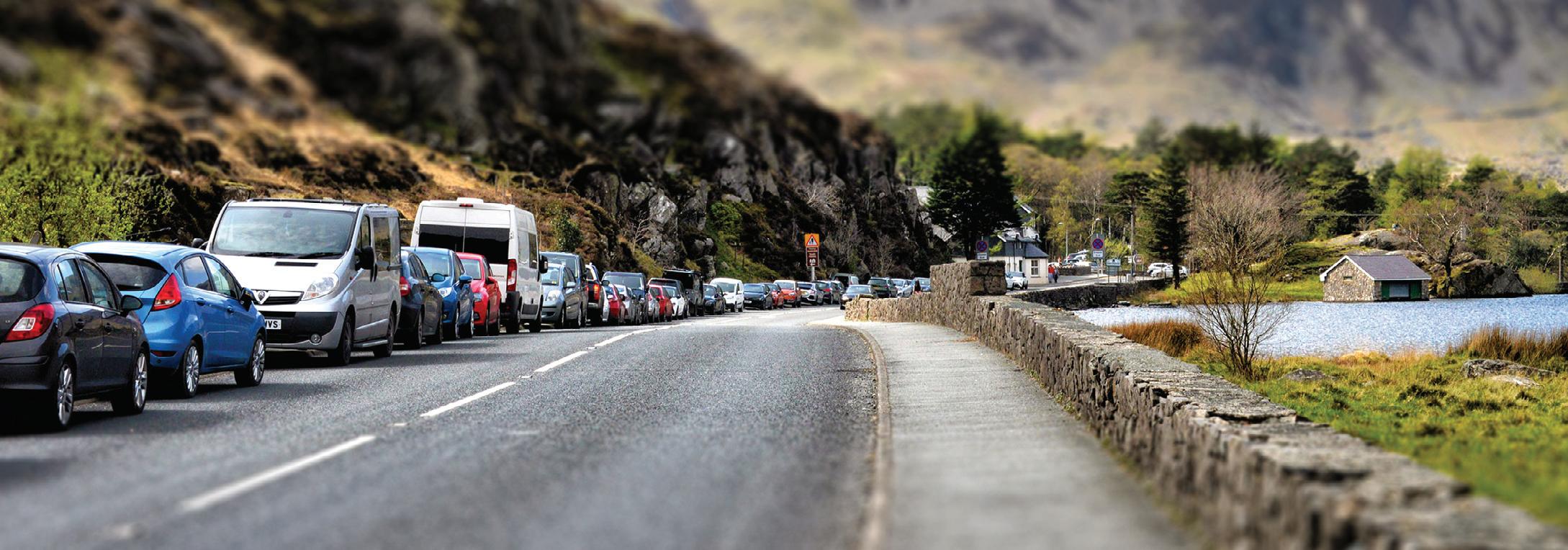
Deputy editor: Deniz Huseyin Tel: 020 7091 7872
deniz.huseyin@landor.co.uk
Editorial director: Peter Stonham
Production and design production@landor.co.uk
Advertising, sponsorship, marketing and exhibition packages
Jason Conboy Tel: 020 7091 7895
jason@landor.co.uk
Christina Pierre
Tel: 020 7091 7959 subs@landor.co.uk
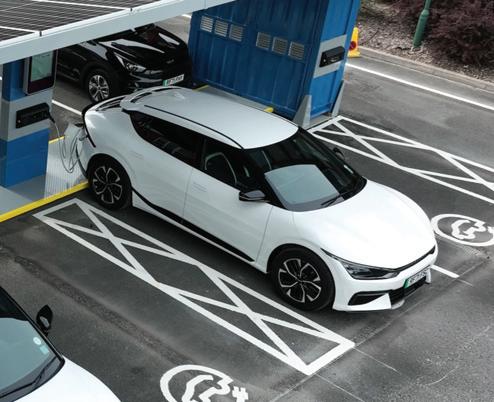
Accounts
Irina Cocks Tel: 020 7091 7854 irina.cocks@landor.co.uk

Managing Director
Rod Fletcher Tel: 0191 280 1410
ISSN: 0962 3599




Traffic officer says public’s photo evidence of dangerous parking could help improve driver behaviour, reports Deniz Huseyin

Ascheme that involves people in the West Midlands sending the police photos of dangerously and thoughtlessly parked cars will change driver behaviour, predicts traffic officer PC Mark Hodson. Operation Park Safe has resulted in “thousands” of fixed penalty notices (FPNs) being issued to motorists since its launch in 2018, said Hodson, who has for many years been pioneering road safety initiatives.
The scheme has also resulted in the removal of hundreds of dangerously parked vehicles, some of which were stolen or cloned, reports Hodson. He has trained police community support officers (PCSOs) across the West Midlands on how to handle third-party reports. “I’ve shown PCSOs what evidence is needed to prosecute various traffic offences – the types of photos and what needs to be included in the reports,” said Hodson.
“If you ask people about policing priorities they say: parking, speeding, littering and dog poo. These come above robberies and anti-social behaviour. Pavement and obstructive parking impact on people’s lives, especially those who are mobility or sight impaired.”
Hodson’s team has been connecting with the public, both in person and through social media, to encourage them to submit evidence. Residents fill in an online form and upload images to their local Neighbourhood Team, which takes no more than 20 minutes, said Hodson. The evidence is then checked by the
Neighbourhood Team, which decides what action to take – either education or prosecution.
The scheme is proving effective at homing in on vehicles owned by criminals, said Hodson. “Now that the public are reporting these badly parked cars we are getting lots of added value. With the public’s help, we can quickly turn up and remove these vehicles. No criminal wants to admit ownership of a car bought with dodgy money, which would leave them open to all sorts of questions. So, we end up selling very expensive cars at auction. This means we’re solving a problem, removing danger and generating revenue.”
West Midlands Police has been working in partnership with local authorities, especially Birmingham City Council. “For a very small investment, we are getting a big return,” said Hodson.
This involves the local authority dealing with civil enforcement issues such double yellow lines, double red lines and no waiting contraventions while the Neighbourhood Team deals with criminal matters such as obstruction, dangerous positions and pedestrian crossing offences.
As part of Operation Park Safe, West Midlands Police has worked with councils to roll out School Streets. The first was introduced in Solihull in 2018 and there are now more than 50 across the West Midlands. “We’ve found that we don’t need to enforce the schemes ourselves. We tell parents, ‘if you have any problems send us photos and we’ll send the drive a ticket in the post’. Peer pressure takes care of things. If a parent drives into a School Street without good reason they’re going to dominate Facebook that evening.”
Hodson describes the increasing involvement of the public in providing evidence as the “Martini Effect”. “It’s a case of ‘anytime, anyplace, anywhere’,” he said. “Someone else on that road who
Pavement and obstructive parking impacts on people’s lives, especially those who are mobility or sight impaired
PC Mark HodsonOperation Park Safe seeks to tackle anti-social parking
isn’t a police officer could be recording your behaviour and submitting it to us.”

There has been a rise in footage of driving offences being submitted by the public using dashcams, headcams and mobile phones, said Hodson.
Two groups becoming increasingly proactive are drivers and pedestrians, he points out. “They are sick of seeing drivers committing offences and they want to do something about it.”
People are starting to understand that they can help improve road safety, cut demand on emergency services and possibly reduce their taxes, he said. Hodson cites Department for Transport figures for 2019, which reported that road collisions cost the country £36bn a year.
Hodson has spent the past 17 years working with West Midlands Police Traffic Department. He started the Road Harm Reduction Team at West Midlands Police and now works with the Central Motorway Police Group.

Along with former colleague PC Steve Hudson, he made headlines six years ago with the launch of Operation Close Pass in the West Midlands. This involved plainclothes officers on bikes recording ‘close pass’ offences, with colleagues stopping offending drivers and giving them anything from on-the-spot education using a ‘close pass mat’ to a fixed penalty notice.

Close pass drivers were also sent fines based on footage submitted by the public. “By 2019 West Midlands Police had received almost 4,000 close pass cases involving footage from the public,” said Hodson. “You don’t actually need that many cases –what you need is a good evidence base. And once people realise what is happening the impact on behaviour change can be huge.”
Third-party involvement in capturing offences such as mobile phone use while driving will become increasingly important, predicts Hodson. “There is absolutely no point in us putting on an operation to catch people using mobile phones while driving because the public are doing it a lot better,” he said.
A new app has been developed to allow pedestrians to use their smartphones to gather evidence of speeding vehicles. Speedcam Anywhere generates a ‘video snip’, which is uploaded to the cloud and analysed using Artificial Intelligence (AI) algorithms. This then creates an analysis sheet, and a link to download their video evidence, which is automatically emailed to the user for uploading to police dashcam web sites.
Trials of the app have resulted in a “favourable reaction” from the police and members of the public, though it has not yet been Type Approved by the Home Office, so speeding tickets cannot be issued, say the app developers. In the meantime, it is proposed that evidence from the app can be presented to police forces so they can issue Anti-Social Driving Orders for Section 59 offences, where inconsiderate driving causes alarm and distress.
The app has been endorsed by the road safety campaign 20’s Plenty for Us, with members set to start piloting the system across the UK. Rod King MBE, campaign director of 20’s Plenty For Us, described the system as a “game changer”. “Speedcam Anywhere bypasses the current resource bottlenecks associated with enforcement,” said King. “We have police forces that desperately want to reduce road offences and speeding offences, but many will only prioritise minimal resources to the task. Speedcam Anywhere can be discreetly and safely used by pedestrians in a very similar way to drivers using dashcams. But, unlike dashcam footage, the ‘analysis report’ requires little police back office analysis other than deciding whether and which offence to sanction. In addition, being digital it can be connected directly to current back office systems to process the paperwork. Hence police retain full control of the outcome.”
The technology behind the system is claimed to provide “irrefutable evidence” of speeding. The developer, Sam Bailey, said: “The app is not critically dependent upon the angle of approach or departure of the vehicle as long as the number plate and side can be seen in the video captured.”
Only a two-second clip of the passing vehicle is needed, Bailey said. “The app essentially gathers video evidence and does not in itself determine the speed of the vehicle. It is the AI analysis of the video snip in the cloud and its report which shows the location, speed limit, time, and vehicle details together with photos of the vehicle as it passes with key times together with the speed. The analysis is able to identify the wheelbase from the make and model of the vehicle, and uses this to identify the difference in timing for the wheels to pass a fixed point, so establishing the speed. The video snip is also available as primary evidence, together with a witness statement for signing.”
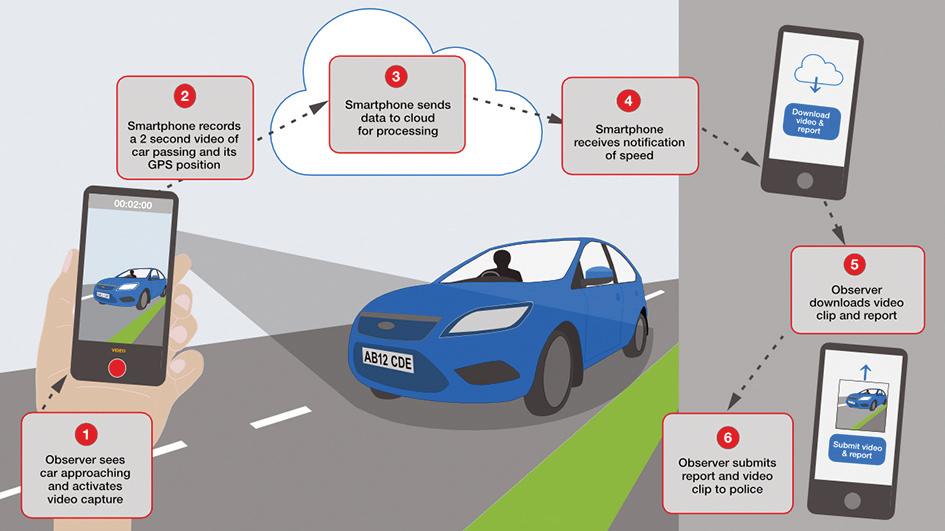
Detective chief superintendent at Lincolnshire Police Andy Cox said the new app is “potentially very significant” as a deterrent to dangerous driving. “Sadly, five people on average die every day in a road crash within the UK. This devastation is preventable and we need to develop innovative methods to eradicate road danger,” said Cox, who is the national lead for fatal collision investigation reporting to the National Police Chiefs’ Council. “One such method is the use of dashcam and headcam technology by the public to capture dangerous and reckless driving and report it to the police. The police cannot be everywhere all of the time but the public can be and as word spreads of this capability it is likely to act as a deterrent to bad driving.”
Cox said: “Public referrals are increasing and enforcement of these referrals is high and outcomes include drivers losing their licence. To further develop this important work I am keen it tackles the biggest single contributory factor in fatal crashes – ‘speed’. I am therefore keen technology providers enable dashcam and headcam devices to capture speeding offences. “
London Tribunal lead to head up national appeals service
The Traffic Penalty Tribunal (TPT) has announced that Caroline Hamilton will be its new chief adjudicator. The tribunal adjudicates on parking and traffic fines issued by local authorities in England and Wales outside London.

Hamilton has been chief environment and traffic adjudicator at London Tribunals since 2010. She starts her new role in July, taking over from Caroline Sheppard OBE, who is retiring after 23 years in post.

Hamilton is a barrister called in 1989. At the Bar, a member of Middle Temple, she undertook a wide variety of criminal (prosecution and defence) and family cases. She was appointed as a part-time London parking adjudicator in 1996 and a fee-paid First-tier Tribunal Judge (Immigration Chamber) in 2000.
In 2010, Hamilton left private practice to join London Tribunals, charged with leading the team of adjudicators determining appeals against civil penalty charge notices issued by the London borough authorities and Transport for London (TfL).
Hamilton said she very much looks forward to the fresh challenge of leading the adjudicators at the TPT, particularly at a time when the jurisdiction is soon expanding to include moving traffic appeals for England (outside London), the nature of which she is very familiar from her time in London.
“For many motorists, the tri-
bunal is the first time that they encounter the justice system,” said Hamilton. “It is vital that they, as well as the enforcing authorities, are enabled to engage with the process.
“The Traffic Penalty Tribunal is fortunate to have the benefit of an online appeals management system that provides userfriendly access to justice. I am committed to ensuring that all parties have the opportunity to participate in the appeal process,
and that appeal proceedings remain open and transparent, informal and expeditious; with adjudicators producing determinations that are timely, focussed and easily understood.”
Hamilton will work with outgoing chief adjudicator Caroline Sheppard during a short handover period. Sheppard said: “I am delighted to learn that Caroline Hamilton has been appointed to succeed me as chief adjudicator. She and I have worked closely together for many years in our respective positions, and her experience is second to none.”
Stuart Hughes, chair of the Parking and Traffic Regulations Outside London (PATROL) Joint Committee, who coordinated the recruitment process for the chief adjudicator role said: “Caroline Hamilton was exceptional during the selection process. Her long-standing tenure leading the London adjudicators,
together with her towering legal experience and acumen, will ensure she hits the ground running in her new role at TPT. I don’t think there could be a better candidate to both maintain the existing high standards of the tribunal and face some of the emerging challenges as the jurisdiction continues to expand.”
PATROL funds and makes provision for the independent adjudication delivered by the TPT.
Laura Padden, director of PATROL, added: “With the introduction of new regulations outside of London, Caroline Hamilton joins the TPT at a time when her experience and knowledge from the capital will be invaluable to staff and the parties to appeal. She is well respected throughout the industry and I am very much looking forward to working with her.”
London Tribunals has yet to name Hamilton’s successor.
The Traffic Penalty Tribunal decides motorists’ appeals against penalty charge notices (PCNs) for parking and other traffic contraventions, issued by local authorities and charging authorities in England (outside London) and Wales. This includes appeals against penalties issued by over 300 local authorities for parking, bus lane, Clean Air Zone, littering from vehicles and moving traffic contraventions.
The tribunal also decides appeals against penalties issued from a number of bridge crossing road user charging schemes in
England, including the Dartford-Thurrock River Crossing (Dart Charge scheme) and the Mersey Gateway Bridge/Silver Jubilee Bridge Crossings (Merseyflow scheme).
Traffic Penalty Tribunal adjudicators are all wholly independent lawyers whose appointments are subject to the consent of the Lord Chancellor.
The tribunal usually decides around 35,000 appeals a year, with over 80% of cases completed in less than a month, and some within just a day, through an online appeals management system.
The online system utilises digital tools, such as an evidence upload portal, instant messaging and Live Chat, together with provision for telephone and video hearings.
Appellants who are not able to get online receive Assisted Digital support from the tribunal’s customer liaison team.
The independent tribunal is funded by a Joint Committee of over 300 local authorities: Parking and Traffic Regulations outside London (PATROL). PATROL fulfils a statutory duty to make provision for the independent adjudication of parking and traffic appeals in England (outside London) and Wales.
www.trafficpenaltytribunal.gov.uk
The role of the Traffic Penalty TribunalCaroline Hamilton Caroline Sheppard OBE
















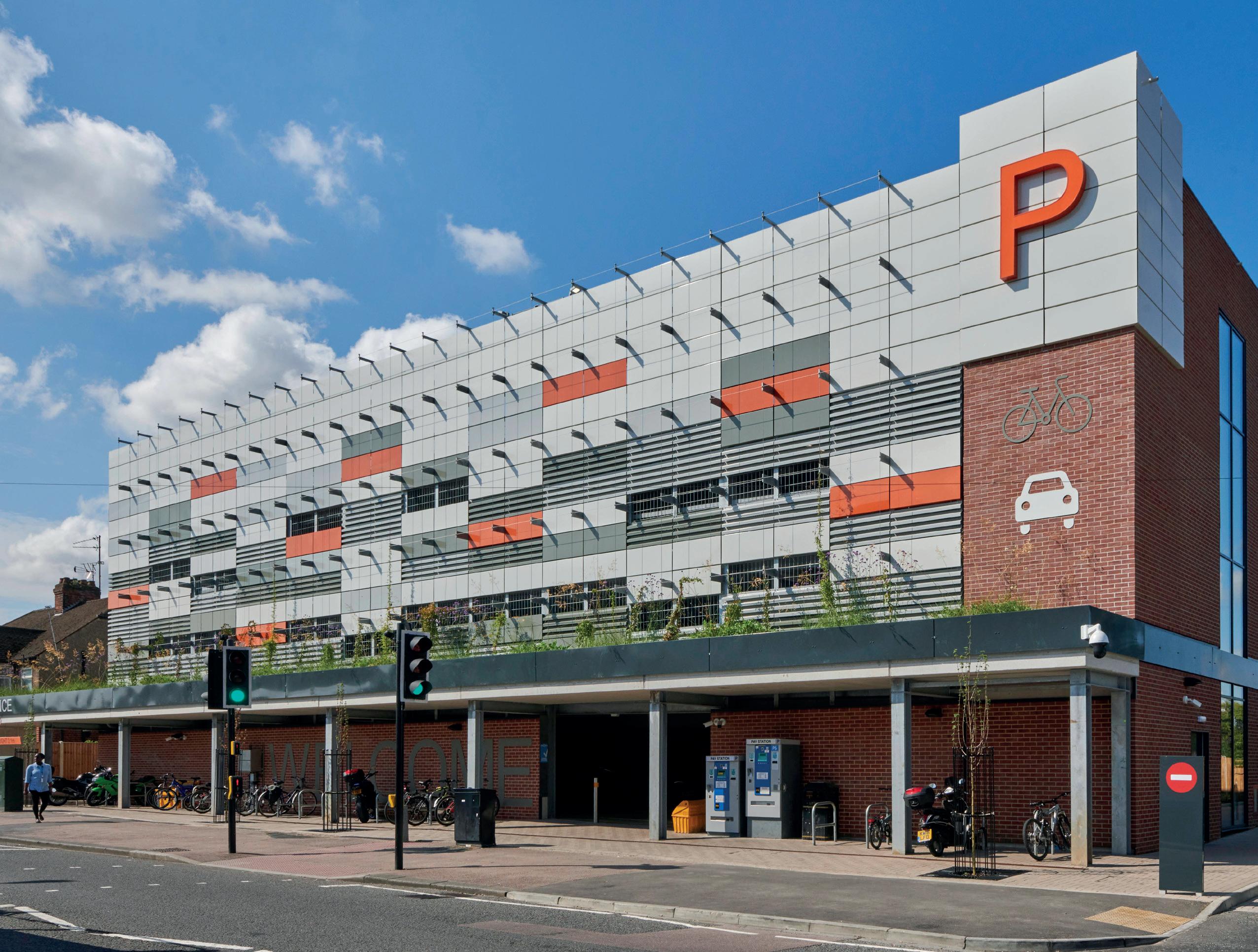



There were also 11,000 fewer vehicles driving at all, each day.”
Mayor of London Sadiq Khan has unveiled plans for the Ultra Low Emission Zone (ULEZ) to extend out to cover almost the whole capital by August 2023.
The ULEZ – which operates 24 hours a day, seven days a week – was launched in April 2019 but initially only covered the same area as the Congestion Charge. In October 2021 it was expanded to all areas within the North and South Circular Roads.
The mayor and Transport for London (TfL) have launched a consultation on the plans to expand the ULEZ, which runs until 29 July 2022.
According to Khan, expanding the ULEZ again will have the biggest effect on emissions relative to the cost to Londoners as a whole, as well as helping to tackle the climate emergency and traffic congestion. Nearly two-thirds of the cost of congestion in London has been attributed to traffic delays in outer London, he said. “This comes at a cost to everyone, impacting businesses, bus customers and essential services.”
Last year, congestion cost the London economy an estimated £5.1bn, said the mayor. Poor air quality resulted in around 4,000 premature deaths in 2019, with the greatest number in outer London, he said.
The proposed expansion would result in the number of vehicles not meeting ULEZ standards falling from 160,000 to 46,000 and the number of vans from 42,000 to 26,000, TfL estimates. These proposals would mean air quality around an additional 145 schools, mostly in outer London, would meet the interim WHO target for nitrogen
dioxide, according to TfL.
Vehicles must meet emission standards to drive in the ULEZ area: Euro 4 for petrol cars and vans; Euro 6 for diesel cars and vans; Euro 3 for motorcycles and mopeds.

The owners of vehicles that do not meet the standards must pay the £12.50 daily charge.
A TfL spokesperson told Parking Review: “On average there were around 47,000 fewer older, more polluting vehicles seen each day in the expanded inner London ULEZ, compared with the two weeks before the expansion, a reduction of 37%.
Mayor of Greater Manchester Andy Burnham is pressing the government to accept that the city region’s Clean Air Zone (CAZ) should be non-charging. This proposal was rejected by the government in February although it did agree to delay the launch of the CAZ until early July and moved the deadline for the scheme to reach the compliant air quality level by two years to 2026.
Burnham has argued that the original charging scheme was unworkable due to global vehicle supply chain issues linked to the COVID-19 pandemic and the cost of living crisis.
The mayor argues his new proposal will “clean up the cityregion’s air in a way that is fair to businesses and residents, and not cause financial hardship to people in Greater
Manchester”. In a letter to environment secretary George Eustice, the mayor outlines plans for an “investment-led, non-charging” Category B Clean Air Zone designed to “incentivise people to upgrade their vehicles using the Clean Air funding already allocated by government alongside additional financial support”.
A Category B scheme includes buses, coaches, taxis, private hire vehicles and heavy goods vehicles.
Burnham said: “We know the original Clean Air Plan caused serious concern among many residents and businesses earlier this year. We listened to what people were telling us and urgently commissioned research into those areas of concern, namely the global vehicle supply chain issues and the ongoing impact of the COVID-19 pandemic. Because of the action Greater Manchester took, we agreed a pause of the scheme with
government.
“We are now confident from the work we’ve been doing that we can secure the right plan for our residents and businesses, which cleans up our air, but doesn’t result in hardship or a single job being lost. We now need government to work with us on this to help deliver our vision.”
Burnham said the original Greater Manchester Clean Air Plan has already upgraded 1,564 higher polluting vehicles and provided funding for the retrofit of 973 buses on Greater Manchester-registered services, with 428 vehicle retrofits complete. Funding has been provided for 56 new buses, with 33 upgraded so far, and 80% of the region’s bus fleet set to be Clean Air Zonecompliant this year.
A Transport for Greater Manchester spokesperson said: “The proposal as it stands would not see charging introduced at a later stage.”
A month after the expansion of the inner London ULEZ, the vehicle compliance rate with the ULEZ standards was around 92%, said the spokesperson. “Compared with compliance levels of 39% in 2017, the percentage of vehicles meeting the required standard more than doubled. This compliance rate was higher than we expected.”
As a result, the income generated from the ULEZ expansion has been lower than expected. This is due to higher compliance, “demonstrating the success of the scheme”, the spokesman said.
“With the further expansion of the ULEZ, TfL expects compliance levels will further increase due to the increased numbers of vehicles that would need to upgrade to a cleaner alternative to comply with the scheme.”
All revenue raised by road pricing is used to implement the Mayor’s Transport Strategy, so income received from the ULEZ is reinvested by TfL into improving the transport network – including its roads, cycleways, buses, and the Tube – and making London’s air cleaner.
Clean air fees of up to £50 a day for drivers entering Newcastle city centre have been postponed by Newcastle and Gateshead councils. The Clean Air Zone (CAZ) is being introduced to reduce levels of harmful pollution from vehicles in response to a government legal order. The zone covers most of Newcastle city centre along with routes over the Tyne, Swing, High Level and Redheugh bridges and will affect taxis, vans, buses, coaches and HGVs that do not meet national emissions standards.
Charges for non-compliant vehicles to enter the zone were due to be introduced from July.
However, the proposals
Newcastle and Gateshead councils submitted to the UK government in October 2021 were not approved until April 2022. The councils have put back the launch date to give those affected more time to prepare. They have started discussions with government on a revised timeline for the launch.
Mayor says zone is vital for public health, reports Deniz Huseyin
Clean Air Act bill will get priority, reports
 Deniz Huseyin
Deniz Huseyin
A proposed Clean Air Act has won first place in the House of Lords ballot of private members’ bills. It topped a shortlist of 25 bills, so will be the first to be introduced in the Lords.
Ballot bills have a better chance of becoming law, as they get priority for the limited amount of debating time available.
The bill, named Ella’s Law after 9-year-old Ella KissiDebrah, who was the first person in the UK to have air pollution recognised as a cause of death, was introduced by Green party peer Jenny Jones. She is seeking to establish a right to clean air and set up a commission to oversee government actions and progress

Jones said: “My Clean Air Act is top of the Lords’ ballot for private members’ bills, which means that it stands a good chance of getting through all
three stages in the Lords, before moving into the Commons.
“The bill aims to protect the public against air pollution, which is one of the biggest public health hazards of our time and responsible for tens of thousands of premature deaths in the UK. I’ve been working on this issue for over 20 years, but this is my best chance to get the government to take decisive action.”
She added: “The government will argue that air pollution has improved a lot in the last two decades and, despite their miss-
ing legal targets and constantly dragging their feet, there is some truth to that. However, the evidence of the negative impacts of air pollution on health has also grown, especially the threat posed by ultra-fine particles.
“My ‘Clean Air (Human Rights) Bill’ would enshrine the right to clean air in UK law across all forms of air pollution: indoor and outdoor; health and the environment; and, for the first time, require joined-up thinking on climate change and local air pollution.”
Four Low Emission Zones (LEZs) have formally started operating in Scotland. The LEZs set an emissions limit for certain road spaces, restricting access for the most polluting vehicles in order to improve air quality.
The plans for schemes in Edinburgh, Glasgow, Dundee and Aberdeen have now been approved by Scottish ministers as required in legislation through the Transport (Scotland) Act 2019.
With the shape and scope of LEZs now agreed across the four cities, local grace periods until enforcement commences have now begun.
• The Glasgow LEZ already applies to buses. For other vehicle types, enforcement commences on 1 June 2023 (1 June 2024 for residents within the zone)
• Edinburgh will commence enforcement on 1 June 2024
• Dundee will commence enforcement on 30 May 2024
• Aberdeen will commence enforcement on 1 June 2024.
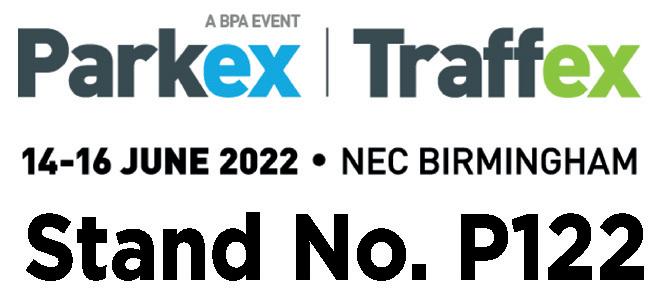
Disabled Motoring UK survey reveals failure of many local authorities to take Blue Badge permit fraud seriously
Disabled Motoring UK has expressed its disappointment at the lack of focus in local authority attitudes towards delivering and enforcing Blue Badge parking. In February, the charity submitted a Freedom of Information (FOI) request to all local authorities responsible for issuing the Blue Badge in the UK.
A total of 207 authorities were contacted in England, Scotland, Wales and Northern Ireland. There were responses from 180 councils.
DMUK said the responses it received indicate that obtaining a Blue Badge has become a “postcode lottery”. However, concerns about a rise in the number of badges being issued as new rules on hidden disabilities have not been realised.
The charity is worried that local authorities are not taking abuse of the scheme seriously and is also concerned few seem to formally review Blue Badge provision.
Heidi Turner, DMUK director of communications and campaigns, said: “Carrying out the Freedom of Information request to all local authorities in the UK has given the charity some valuable data on Blue Badges and disabled parking across the country.
“We continue to be disappointed by the lack of enforcement of the scheme and would welcome any local authority to get in touch with the charity if they want to decrease levels of abuse in their area.
“With numbers of Blue Badge holders increasing it is clear to us that all local authorities need to carry out a full review of their Blue Badge parking provision so
they can ensure that demand for parking is met in their local area.”
The total number of applications for Blue Badges made over the three-year period from 2019-2021 was 2,897,982 meaning that 187,230 applicants were turned down for a Blue Badge.
DMUK calculates this equates to 6.5% of Blue Badge applications. (Blue Badges are usually valid for three years)
Eligibility guidelines are issued centrally from Department for Transport (DfT) to local authorities to use so that they are issuing Blue Badges to the right people.
“It is worth noting that there were vast differences between local authorities in numbers of applications that were turned down,” said Turner.
Some local authorities approved nearly 100% of applications they received, but the London Borough of Redbridge had the lowest approval rating with only 66% applications approved in 2021.
“The statistics show that there may be big differences across the country in their interpretation of guidelines, meaning obtaining a Blue Badge becomes a ‘postcode lottery’,” she said. “The results showed that there are currently 2,710,752 valid Blue Badges issued across the UK. The response rate was 87%, so a rough estimate for the total including the 27 authorities that did not respond would be 3.12 million Blue Badges in circulation in the UK.”

In August 2019 the eligibility criteria in England changed to include people with hidden disabilities. This change did not come in across the UK, but some local authorities in Scotland, Wales and Northern Ireland were issuing and recording this data.
The FOI request showed that there are
66,612 people across the country who receive a Blue Badge purely because of a hidden disability.
When the criteria changed in 2019 DMUK was concerned that there would be flood of new Blue Badge holders and this would have negative consequences for Blue Badge holders as a whole because there would be more pressure on an already over-subscribed parking provision.
“It seems to us that this figure shows that the new criteria is being administered in the right way and we’ve not seen anywhere near the increase in Blue Badge holders that we predicted because of it,” said Heidi Turner.
The FOI request asked local authorities questions about abuse of the scheme. DMUK says it is alarmed to see that many local authorities do not record reports of misuse and abuse of the scheme.
“Only 57% of authorities that responded recorded this data and those that did seemed to have very few reports,” reported Turner. “It makes us wonder that even those that do record this data aren’t taking it seriously enough. According to our FOI request there were only 4,815 reports of misuse across the entire UK in 2021.
“We’d encourage anybody who feels that a Blue Badge may be being abused to get in touch with their local authority so that the problem of misuse and abuse is kept on their radar,” she said.
“Some local authorities are doing great work in enforcing scheme and holding abusers of it to account. Our FOI request revealed that 585 prosecutions took place in 2021 totalling in £121,507 in fines for abusers and costs totalling £146,661.35.”
DMUK asked local authorities when they last reviewed Blue Badge parking provision in their area.
“These results were shocking as only 46% of authorities (95 authorities) had carried out any kind of review in the last 10 years,” said Turner. “For 18 authorities it had been over 10 years since a review had taken place, with Bury Borough Council reporting that the last time they reviewed Blue Badge parking was in 1993, which 29 years ago!
“More alarming than this is that 43 authorities report never carrying out a review of Blue Badge parking provision. The remaining 51 authorities that responded claim they do not hold data of if or when a review has taken place.”
Disabled Motoring UK is the national charity which supports disabled drivers, passengers and Blue Badge holders. It works with government and businesses to improve parking, refuelling and access provision for disabled people, so that they can access the goods and services that they need. DMUK also campaigns for and supports scooter and wheelchair users, families and carers.
www.disabledmotoring.org








English local authorities can now apply to the government to use ANPR cameras to enforce a range of moving traffic offences.
London authorities already have the powers under separate legislation while councils in Wales have been able to apply to the Welsh Government for the powers for several years, although so far only Cardiff has done so.
Since 31 May, councils have been able to issue fines to those driving into a bus lane, stopping in a yellow box junction, making banned right or left turns, illegal U-turns and driving the wrong way in a one-way street.
The UK government will give councils the new powers under Part 6 of the Traffic Management Act 2004 via a package of three statutory instruments (SIs).
In a 2020 policy paper, the government pledged to change the law and give local authorities the ability to enforce these offences themselves.
In explanatory notes accom panying the law change, the government said the change may help “improve air quality through reduced traffic congestion”, and “encourage behavioural shift towards sustainable travel choices” by improving bus reliability and making cycling easier.

Fines that can be imposed can range from £20 for lower level penalties paid promptly up to £105 for late payment of
higher level penalties (such as bus lane contraventions, or parking a vehicle on a cycle path).
Unlike funds raised from speed camera fines, which are transferred to central government, surplus funds from moving traffic enforcement will be kept by the local authority. This surplus must be spent to: recoup costs of enforcement; pay for public transport provision; pay for highway improvement projects; or pay for environmental improve-
ments in the authority’s area.
Kent County Council has already stated that it will apply for designation orders to use the powers. The authority plans to use ANPR technology to improve compliance and road safety as well as tackling congestion.
It is currently unclear how many councils will apply for the powers, so it may be necessary to deliver Designation Orders in tranches, said the government.
The UK Government is set to create a low-speed, zeroemission vehicle category which, it says, “is independent from the cycle and motorcycle categories”.
Speaking in the House of Lords, Baroness Vere of Norbiton, parliamentary undersecretary of state at the Department for Transport, said: “Safety is at the heart of our plans to create a regulatory framework for smaller, lighter, zero-emission vehicles, sometimes known as e-scooters.
“Their popularity is clear and new rules are needed to improve safety and crack down on illegal use whilst unlocking innovation and growth in this emerging multi-billion-pound industry.
“New powers would allow the government to decide the vehicles that fall into this new category in the future and how they should be regulated to make sure that they are safe to use. We hope that e-scooters will be the first of these vehicles.”
The move had been
suggested by transport secretary Grant Shapps in April.
Speaking to the Commons transport select committee he had promised to “take powers to properly regulate and then be able to decide the usage of [e-scooters]”.
This new legislation, which forms part of a new Transport Bill, had expected to be included as part of the Queen’s Speech.
Vere’s announcement has been welcomed by micromobility operator Voi.
Jack Samler, general manager at Voi UK and Ireland, said: “Shared e-scooter schemes,

such as Voi’s, have successfully demonstrated that they can be safely integrated with other forms of public transport, bicycles and walking to give people carbon-free transport options.”
UK-based mobility brand Beryl, which operates bike, cargo bike, and e-scooter schemes, also welcomed the announcement. The firm said the success of its rental schemes has shown the demand for sustainable transport.
Beryl CEO and co-founder Phil Ellis said: “We welcome any legislation that seeks to remove barriers to sustainable transport and encourage the take up of greener transport options, reducing road congestion while improving air quality and public health.
“The success of our schemes has shown that, by instilling high standards of safety and operational control, you can introduce safe and sustainable schemes that can form an essential part of an integrated multimodal urban transport network.
Street works carried out by poorly performing utility companies will be inspected more frequently, the Department for Transport has announced.
Under the new rules some utility firms will face more inspections from highways authorities after reinstating streets after completing works. The utility company will have to pay fees for these inspections.
The changes mean utility firms will be required to submit up-todate information on traffic management and lane closures using the Street Manager digital service. Also, highway authorities will have to submit start-and-stop notices for their works, so that upto-date information is available via Street Manager.
The changes followed a consultation earlier this year, which received responses from highway authorities, utility companies, representative groups and technology companies.
Failing utility firms to be inspected more frequentlyOKAI VEHICLES, UNSPLASH RUDY ISSA, UNSPLASH
Sustrans index reveals attitudes to walking, cycling and wheeling
Banning pavement parking would help all people to walk or wheel more, research by Sustrans reveals. The Walking and Cycling Index study highlights several barriers which people face when walking, wheeling and cycling in their local areas. One is obstruction caused by pavement parking.
Previously called the Bike Life survey, Sustrans has extended the scope of the report to include walking and wheeling.
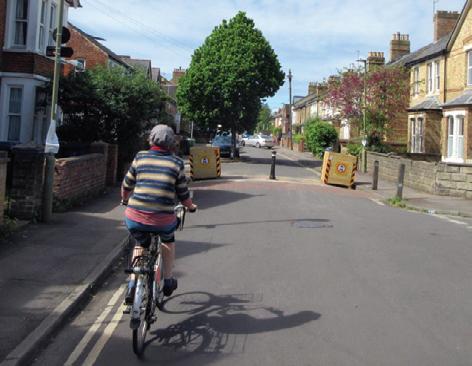
Sustrans surveyed more than 24,000 people from 18 cities and areas across England, Scotland, Wales, Northern Ireland and the Republic of Ireland.
The report found that banning pavement parking would help 70% of all residents to walk or wheel more. It also revealed that 72% of residents think wider pavements would encourage them to do so.

Pavement parking is currently prohibited in London. The UK
government is currently considering extending this across England. The Scottish government is set to introduce a ban on pavement parking in 2023.
The Walking and Cycling Index also shows that just 56% of disabled people and 55% of residents on low incomes feel welcome when walking and wheeling in their neighbourhood, with only 52% of people believing it is safe for children to walk in their local area. This compares
Statistics for the first year of the City Road pavement parking ban in Cardiff indicate that there has been a reduction in offending, reports Rhodri Clark
However, uneven enforcement contributed to fluctuating numbers of penalty charge notices (PCNs) being issued each month.
In 2020 the Welsh Government said it aimed to give all local authorities powers, from 2022, to fine people for parking on pavements, but Cardiff Council moved earlier. In May last year, it introduced a pilot ban along City Road using the Road Traffic Regulation Act 1984.
Enforcement is carried out under the Traffic Management Act 2004, primarily using a camera car. By the end of March, 2,081 PCNs were issued for pavement parking offences detected by the camera car. They peaked at 462 in July. The lowest total for a month was 81 in September. In the first three months of 2022, PCNs per
month ranged between 202 and 250.
Enforcement by officers on foot resulted in 100 PCNs in May 2021. The monthly numbers were much lower for most of the year but increased fourfold from 24 in February to 96 in March. The enforcement figures reflect variations in staffing and enforcement activity through the year. Of the appeals processed to date, 280 related to camera enforcement. Of those, 162 were allowed and 118 rejected. Of the 49 processed appeals against PCNs issued in the street, 31 were allowed and 18 rejected.
The council’s new cabinet, still to be sworn in following this month’s elections, will evaluate the pilot’s first year and decide whether to continue with the enforcement and whether to apply the enforcement in other streets.
When Parking Review visited the southern end of the road last autumn, only one parked vehicle on a pavement was observed.
to 69% of non-disabled people, and 74% of those in managerial or professional roles
People walk or wheel more frequently than any other form of urban transport, with 50% doing so at least five or more days each week. This compares to 39% for car use, 11% who use public transport and 5% who cycle at least five or more days each week.
However, proximity of local services and amenities prevents
people walking and wheeling more, as just over half of respondents (55%) agreed they could easily get to many places they need to visit without having to drive.
A total of 79% of people support the creation of 20-minute neighbourhoods where amenities and services, such as shops, green space and GPs are located within a 20-minute return walk or wheel of where they live.
However, the research found 27% of households are outside of a 20-minute return walk of a food shop, rising to 36% of households that are not within this distance to a GP.
The index reveals strong demand for more Low Traffic Neighbourhoods (LTNs) in urban areas across the UK, according to Sustrans. The charity found that 66% want more LTNs while just 12% are opposed to them.
More than half of residents (51%) agree that closing streets outside local schools to cars during school drop-off and pick-up times would improve their local area while 20% disagree.
vehicles from entering the zones had been ripped out, while people had used power tools to try and remove the planters.
The councillor stated on Twitter: “I am absolutely fed up with a culture that demands we drive everywhere and encourages vandalism to maintain this.”
Bollard and planters at three new Low Traffic Neighbourhoods (LTNs) in East Oxford have been vandalised.
The schemes were introduced on 20 May by Oxfordshire County under an experimental traffic regulation order (ETRO). A consultation on the schemes will run for the next six months, during which time changes can be made, after which the schemes will run for a further sixmonth trial period.
The East Oxford schemes have sparked local protests, but anti-LTN candidates failed to make an impact at the local elections on 5 May. Candidate Sadiea Mustafa-Awan defected from the ruling Labour party over its support for LTNs, standing as an independent in Oxford’s Littlemore ward, but failed to win the seat.
Oxfordshire councillor Damian Haywood said that bollards blocking
The council will be seeking ways to make the bollards more secure, he said. “It is a small minority of people that are getting a bit angry when they see an obstruction on a road they have always driven down.”
Haywood urged people to give the new zones a chance and to complete the online consultation.
A council spokesperson said: “These measures cannot be implemented permanently without engagement with those affected and we want to hear people’s views. There are a number of key factors behind the locations chosen for the implementation of LTNs. These include poor air quality, high traffic volumes, and number of vulnerable road users living in or accessing the area.”
The council introduced its first three LTNs in the Cowley area of Oxford in March 2021.

Traffic is one of the biggest barriers to children walking to school, with 15% of parents naming it as a reason their child does not walk, according to polling released during Walk to School Week (16-20 May).
Living Streets said that with there being 10.3 million pupils in the UK, this means tens of thousands of them are being denied the physical and social health benefits of being more active. In contrast, the charity observed that a generation ago, 70% of primary school aged children walked to school but now it’s less than half.

Schools being too far away from home (17.7%), having to go elsewhere afterwards (12%), pavement parking (11.4%) and lack of safe walking routes (10.7%) were also barriers for UK parents.
Stephen Edwards, chief executive, Living Streets said: “We’re


stuck in a catch-22 where families see driving to school as the safest way to protect their children from traffic. Leaving the car at home will reduce chaos and road danger around the school gates. It’s also a great way for children to learn about road safety in a real life setting and build their confidence in managing risk.”
Living Streets encouraged families to walk, wheel, cycle, scoot or ‘Park and Stride’ for the whole week to see the big differences that come from small steps, from healthier and happier
children to fewer cars outside the school gates.
The charity campaigns on this issue year round, working with schools, local authorities and parent groups to help improve the walk to school. “We want to enable as well as encourage more families to walk to school,” said Edwards. “We’re here to help parents who are worried about safety around their child’s school. Car-free zones, 20mph limits and better crossings can all help make the walk to school safer and we’re here to help people campaign for them in their area.”
Ford has launched an initiative called Park the Car, which encourages car users to cycle or walk for short journeys.

The campaign will see Ford sponsoring cycling events, becoming a presenting partner of the RideLondon festival of cycling, that ran from 27-29 May.
It is also encouraging young people taking part in its Driving Skills for Life Programme to consider active travel options.
Stuart Rowley, president of Ford of Europe, said: “Park the Car is a new initiative from Ford. It is probably the last thing many people would expect from an auto maker. However, driving responsibly is no longer just about safety. It’s also about caring for our environment and our health – active travel, and walking or cycling once a day, can bring about significant change.”
Parents drive children to school because of road safety fears

The University of Warwick is working with APCOA Parking to develop a more flexible approach to managing the car parks across its main campus.
Following the award of a 5-year contract at the end of September 2021, the parking contractor has worked to implement a new approach to managing the 24 car parks across the out-of-town site.
APCOA has developed a cloudbased technology called Parkway to offer end-to-end parking management. At Warwick over 6,000 parking spaces are now managed and enforced via APCOA’s Parkway ANPR (automatic number plate recognition) solution which is fully integrated into its digital platform.
Parkway provides a range of customer services including prebook and a self-service portal for use by staff and students. This has enabled the college to create a charging regime using account linked payments based on car park locations and permit
tariffs aligned to actual car park visits made by drivers using daily charging methodology. The maximum spend limit thresholds reduce the amount users spend on their weekly parking.
The APCOA Connect digital payment system offers AutoPay and LatePay features at all car park. Cashless kiosks have been installed at the Sports & Wellness Hub and the Arts Centre, two of the busiest uses of parking on site. The company will also be providing an option called APCOA ScanPay.
The digital platform also manages concessions for Blue Badge and residents and provides whitelist solutions which support third-party stakeholder parking permissions.
The Parkway system features multiple different dashboards which give the university realtime access to information and analytics, allowing them to make informed decisions.
Parvez Islam, director of environmental sustainability at the University of Warwick said: “This project has revolutionised the
Companies within the Bristow & Sutor Group have made a commitment to work in a more collaborative manner. The group is a partnership between Debt Recovery Plus (DRP), Credit Style, and Bristow & Sutor. Over the past year, all three businesses have worked together in order to ensure that successes, achievements and insights gained by each team contribute to performance improvements and best practice strategies for all.
In a management restructure, Bristow & Sutor Group has announced three internal promotions with the aim of consolidating group activities, methods and approaches even further.
Steve Bramley has taken up the mantle of group sales director, Emma Watson has been appointed as client development manager and Paul Kyte has become the new head of strategic accounts. Between them, these three colleagues have worked in various roles throughout the companies that form the Bristow & Sutor Group.
• Credit Style, based in Sheffield, offers white label collections outsourcing, pre-legal collection services, field visit remediation solutions and house legal services as a fully licensed, SRA law firm.

• DRP, headquartered in Manchester, is a debt recovery service for the private parking sector.
• Bristow & Sutor, based in Redditch, collects local Council Tax, non-domestic rates and unpaid penalty charge notices (PCNs) and scored a 100% in an independent audit of adherence to the CIVEA code of practice.
Steve Bramley has worked in the debt collection industry for 28 years and co-launched Credit Style in 2007 to provide bespoke and fulllifecycle credit and debt recovery services. “As a joint force our business now has the full capability to deliver a debt recovery service that spans the entire delinquency journey, and our business is excited to support its clients in achieving best in class debt reduction.”
Emma Watson joined Bristow & Sutor as head of external communications in 2019, having previously spent ten years working in the enforcement industry. “I am thrilled to head our client solutions team,” she said. “Bristow & Sutor have always been recognised for the exceptional
way we manage the university’s parking arrangements. The new system and technology provide much needed improvements, supporting our sustainable transport strategy and modal shift objectives. The flexibility from APCOA to meet our needs and requirements will help generate income and support our sustainability targets to achieve net zero carbon emissions.”
George Saxon, head of transport systems and operations at the university, said: “The APCOA team have been great to work with, providing a full package of expertise and on-site skills to successfully guide the project from conception to completion in a short time window that will maximise our strategic and operational benefits.”
Kim Challis, APCOA’s regional managing director for UK & Ireland, said: “It’s been great to work with the University of Warwick, which employs nearly 7,000 people, teaches almost 30,000 students and is consistently ranked among the UK’s top 10 universities. We’ve been pleased to deliver this complex project in a short timescale and help them achieve its aims.”
support they give to clients and this approach to partnership working is something I look forward to developing across the rest of the group.”
Paul Kyte joined Bristow & Sutor in 2009 after two decades of experience on parking projects and services. He is a council member of the British Parking Association (BPA) and most recently was head of client development for Bristow & Sutor. “Being appointed head of strategic accounts will allow me to further develop our relationship with existing clients, such as Transport for London, and also explore and support other opportunities across the group”
Bristow & Sutor has also hired Michelle Giles and Peter Haywood, who both had careers in local authorities working across revenues and benefits.

New client development manager Michelle Giles has previously worked for 15 years in local government, including roles with Eastleigh Borough Council and Basingstoke and Deane Borough Council. She has achieved an IRRV Level 3 Diploma in Local Taxation, Benefits & Advice as well as completing both HCEG Taking Control of Goods Level 2 and Level 3.
Peter Haywood has 32 years of council, public and private sector experience, having worked across four local authorities in Preston City Council, Kendal Town Council, Burnley Borough Council and South Ribble Borough Council. He is a past president of the Lancashire arm of the IRRV (Institute of Revenues, Rating and Valuations), and has built a solid understanding of the needs and obstacles involved in this space.
Circular Ecology works with YourParkingSpace on offset project
YourParkingSpace has partnered with environmental consultants Circular Ecology to launch a carbon neutral car park.
The car park is located at YourParkingSpace’s offices at the Republic London campus.

YourParkingSpace has sought to fully offset carbon emissions from drivers parking at the premises by finding an equivalent amount of carbon savings. The initiative has involved assessing the average distance driven by motorists to and from the car park, as well as establishing emissions data for each vehicle in order to calculate the car park’s total carbon emissions.
The site’s emissions will be offset with Gold Standard carbon credits, a World Wildlife Federation (WWF) scheme that ensures offset carbon projects feature high levels of environmental integrity and contribute to sustainable development.
Besides carbon savings, the site also runs on 100% renewable energy. YourParkingSpace and Circular Ecology have also arranged community benefits such as provision of clean cookstoves, clean water and ensuring four trees are planted for each tonne of carbon that is offset.
Harrison Woods, chief executive at YourParkingSpace, said: “Launching the world’s first carbon neutral car park is yet another example of our commitment to find innovative ways to help combat the global issue of climate change.”
Dr Craig Jones, director at Circular Ecology, said: “Carbon neutrality offers a mechanism of combatting climate issues, however, until now this has been an untapped opportunity within the parking industry.”
May Molteno, ethics, sustainability and stakeholder engagement at Trilogy Real Estate, the owners of the premises, added: “Taking responsibility in this way is the mark of a grown-up business. I am genuinely impressed YourParkingSpace has worked to create a parking option that is carbon neutral.”

Parking technology company ZatPark is integrating with FindParkPay, a mobile payment gateway that negates the need to download and set up an app.
FindParkPay was founded via Falmouth University’s Venture Studio, Launchpad. The integration with ZatPark is the new company’s first. The agreement will initially be implemented at the Priory car park in St Austell, a Cornwall Council car park. FindParkPay began working with St Austell in late 2021, while ZatPark has been working with Cornwall Council since 2019.
Jono Clark, development technologist at ZatPark, said: “We’re all about innovation so working with a start-up like FindParkPay is great. We’re looking forward to making a success of the integration.”
Tim Macknelly, director at FindParkPay, said: “The integration has been really easy and the ZatPark team has been very helpful on the technical side. This has given us access to their platform, which is one that is widely used in the parking industry.”

Flowbird Smart City UK has achieved Carbon Neutral + (CNS) in recognition of its commitment to offer environmentally-friendly operations and products.
The accolade recognises companies that have carbon management strategies in place to calculate and reduce their carbon footprints in business operations.
In order to achieve CNS, Flowbird Smart City UK was audited by Carbon Footprint. The audit comprised a review of the company’s vehicle and mileage use, and its plans to reduce its carbon footprint in its offices and via home working over a 12-month period.
Danny Hassett, Flowbird Smart City UK’s managing director, says: “Our customers demand suppliers who are serious about reducing their carbon footprint. Flowbird Smart City UK has always recognised the impact of climate change, and for many years we have invested in developing high quality solar parking machines – 98% of machines we sell have solar. On top of this, we also have the technology for emissionbased charging at our pay & display machines and a range of EV chargepoints.”
Strong green credentials are increasingly a factor when customers look for in suppliers. “Carbon neutral status will become a necessity for local authority tender, a key customer sector for Flowbird Smart City UK,” said Hassett. “Carbon Neutral + status is a recognition of our longstanding commitment to responding to our own and our customers’ desires for greener operations and products.”
As part of working to get CNS, Flowbird Smart City UK has sponsored a number of projects in developing countries and funded the planting of 444 trees within various UK-based schools.
CNS lasts for one year, and the company will then be re-audited.
We currently supply and have vacancies around the UK for Permanent and Temporary positions:

• Civil Enforcement Officers
• Environmental Enforcement Officers
• Parking Back Office (Appeals/Notice Processing/Correspondence)
• Parking Change Management
• Interim Parking Managers
• Car Park Attendants/Marshalls/Stewarding
• Parking Supervisors (Both Enforcement and Back Office)

• Parking Management (Both Enforcement and Back Office)
• Heads of Parking/Directors
• Parking Technologies (Business Development and Project Managers/ Field Service Engineers/General Managers)
• Off Street Parking (Business Development, Contract Managers and Regional Managers)
• CCTV Operators – SIA and BTEC qualified
Looking for staff or need employment?
Please contact our experienced team on:
Tel: 0203 668 5680
Email: parking@unity-recruitment.co.uk

Web: www.unity-recruitment.co.uk


The Enforcement Summit 2022 will explore the latest policy, legislative and operational developments in the field of traffic management, parking operations, air quality schemes and debt recovery.

The event encompasses: local authority enforcement operations; Clean Air Zones, management of parking on private land; and the collection of road traffic, parking and other debts.
Keynote speakers and expert panels will examine themes such as:
n Civil parking enforcement
n Moving traffic regulations

n Clean air schemes
n Road user charging
n Tackling nuisance vehicles and persistent evaders
n The regulation of parking and trespass on car parks and private land
n Balancing education and enforcement to encourage compliance
n Intelligence-led enforcement and debt recovery

n Managing appeals and representations
n Engaging with vulnerable debtors

n The prevention of anti-social behaviour (littering, fly-tipping, noise issues)
n The role of civil enforcement agents in multi-agency operations
n Training the front line and the back office
n The use of ANPR as an enforcement and intelligence tool
n The collection, management and use of data
The Enforcement Summit will provide an opportunity to meet peers, colleagues and other professionals in both structured discussions and at informal networking sessions, including a drinks reception to close the day.
Public Sector Delegates FREE* Commercial Delegates £245 + VAT

* Conditions apply
ENFORCEMENT SUMMIT 2022 EXHIBITION
Confirmed exhibitors include:
Visitors: The exhibition will enable attendees to check out the latest systems and services on offer to the traffic, parking and air quality management sector.
The Enforcement Summit 2022 provides your company with the perfect opportunity to carefully target the marketing of your products and services to those working in the parking and traffic, clean air and public space sectors.

To participate in this sector-defining event contact: Jason Conboy T: 020 7091 7895 E: Jason@landor.co.uk
www.enforcementsummit.co.uk
















Editorial
Managing editor:
Mark Moran Tel: 020 7091 7871
mark.moran@landor.co.uk
Production and design
production@landor.co.uk
Advertising, sponsorship, marketing and exhibition packages
Jason Conboy
Tel: 020 7091 7895 jason@landor.co.uk
Subscriptions
Christina Pierre
Tel: 020 7091 7959 subs@landor.co.uk
Accounts
Irina Cocks
Tel: 020 7091 7854
irina.cocks@landor.co.uk
Business manager
Rod Fletcher Tel: 0191 280 1410
Printed by: Pensord Tram Road, Pontllanfraith, Blackwood NP12 2YA
Published by: Landor LINKS Ltd, Apollo House, 359 Kennington Lane, London SE11 5QY
© Landor LINKS Ltd 2022
www.landor.co.uk
Registered members of:



The Independent Press Standards Organisation www.ipso.co.uk
The Professional Publishers Association www.ppa.co.uk
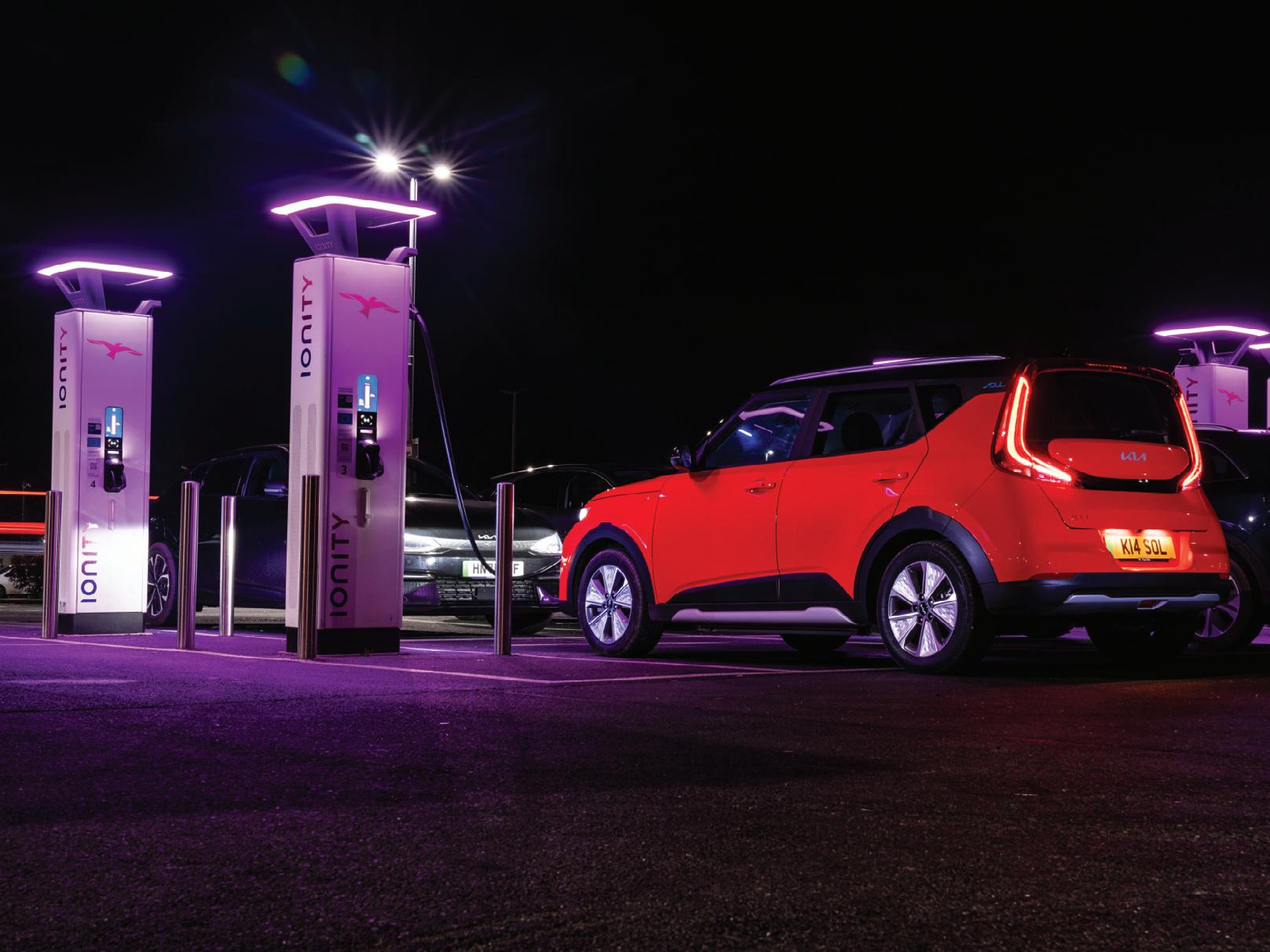
The delivery of zero-emission vehicle infrastructure involves the cooperation of a wide array of public and private sector organisations.
Central to the provision of public charging are the chargepoint operators (CPOs), which are in themselves representative of the diverse range of commercial interests at play in this sector. Several CPOs are owned by energy companies, others by utilities providers or backed by carmakers, while there are a number of independent networks with an assortment of backers.
The CPOs, in turn, form part of a network of organisations that are facilitating, financing and managing the provision of chargepoints. This web includes central governments and their agencies, regional and local authorities, motorway service operators, retailers, property developers and parking providers.
Parking is key to the future of zero-emission motoring. Whether it is on a driveway, at the kerbside, in a public car park, a workplace, a shopping centre or at a motorway service area, electric vehicles re-charge when parked. The parking sector is a surprisingly complex ecosystem comprising councils, car park operators, payment and technology providers.

It was the extensive coverage that Parking Review magazine gave to the development of EV charging policy, technologies and business models that led to the launch of the EVolution website and magazine. Our mission is to connect the many players involved in the provision of zeroemission charging infrastructure. Please keep in touch.
Mark Moran Editor
The average price of charging an electric car on a pay-as-yougo, non-subscription basis at a publicly accessible rapid charger in Great Britain has increased by 21% to 44.55p per kilowatt hour (kWh) since September, according to analysis by the RAC.
RAC Charge Watch is an initiative designed to monitor the cost of public electric car charging in the UK. Run in association with the national FairCharge campaign, Charge Watch follows the motoring organisation’s Fuel Watch service which records petrol and diesel prices.
The 7.81p per kWh increase, from 36.74p at the end of last summer, means that the average cost to complete an 80% rapid charge of a typical family-sized electric car with a 64kWh battery has increased by £4 over this period, from £18.81 to £22.81 now (cars revert to slower charging speeds beyond 80% to preserve battery health).
In contrast, the cost of filling a 55-litre family car from empty to 80% has increased by a huge £14.54 since last September, from £59.67 to £74.21 – a 24% increase.
The RAC’s analysis shows
that it now costs on average 10p per mile to charge at a rapid charger, up from 8p per mile last September. This is nearly half the cost per mile compared to filling a petrolpowered family car, the cost of which has risen from 15p per mile since the end of last September to a staggering 19p per mile now. The cost per mile for a similarly sized dieselpowered car is still higher at nearly 21p.
The average price of charging at the quickest ultrarapid chargers – which have a power output of 100kW-plus and can deliver a charge to a compatible vehicle in as little as 20 minutes – has increased by a greater margin of 16.76p per kWh, from 34.21p per kWh in September to 50.97p in May. This means the cost to charge a vehicle to 80% has risen from £17.51 to £26.10. This, however, is still £48 cheaper than filling a petrol-powered car to 80%, although electric car drivers do not get quite as many miles from an 80%
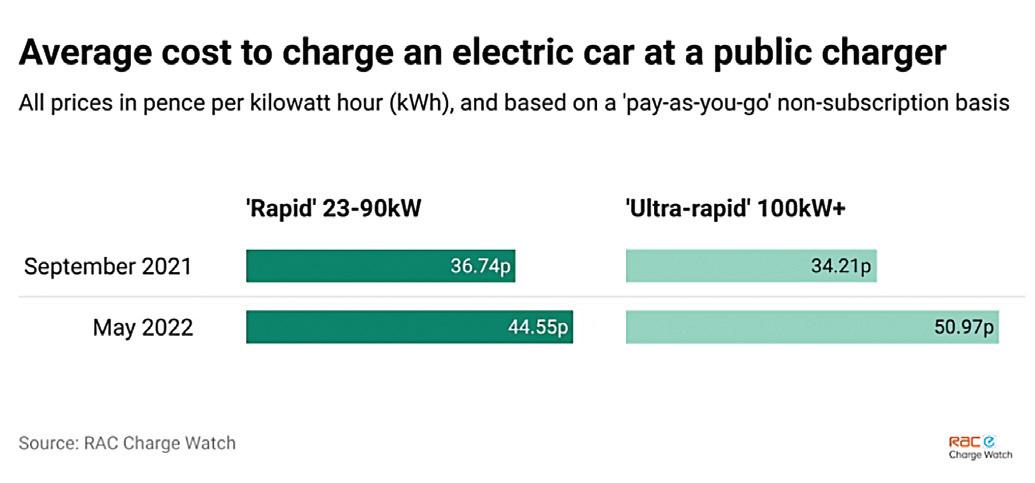
charge as drivers of petrol cars do from an equivalent fill-up of a tank of fuel.
The price increases facing drivers of electric cars using publicly accessible chargers can be explained by the rises in the wholesale cost of electricity, which itself is driven by hikes in the cost of gas – especially since a considerable proportion of the UK’s electricity is generated by natural gas-fired power stations.
Ofgem figures show that the wholesale cost of gas doubled between the end of September 2021 and the end of March this year, with wholesale electricity prices rising by around 65% over the same period.
While the cost of charging a zero-emission electric car remains good value compared to topping up a petrol or diesel car, as things stand drivers who cannot charge up at home –which could be as many as one-in-three – are penalised by having to pay a higher rate of VAT on electricity than those who can, something the RAC-
backed FairCharge campaign consistently points out. This, the RAC said, risks putting off a huge number of drivers from switching to electric next time they change their vehicles.
The FairCharge campaign is calling for the 20% VAT rate currently charged on electricity at public chargers to be cut to match the 5% levied on domestic electricity, thus making it an easier decision for those who cannot charge at home to switch to an electric car. Doing so would see the cost of charging up at a rapid charger cut by 5.57p per kWh, and at an ultra-rapid charger by 6.37p. This would reduce the cost of an 80% charge by £2.85 and £3.26 on average at rapid and ultra-rapid chargers, respectively.
RAC electric vehicle spokesperson Simon Williams said: “Just as the price that drivers of petrol and diesel cars pay to fill up at the pumps is driven by fluctuations in the world oil price, those in electric cars are affected by gas and electricity prices. But while electric car drivers may not be immune from the rocketing price of wholesale energy –most notably gas, which in turn dictates the cost of electricity – there’s no doubting that charging an EV still represents excellent value for money compared to filling up a petrol or diesel car.”
InstaVolt has raised tariffs across all its rapid chargers in response to continued pressure from wholesale energy costs. Since 4 May charging on the InstaVolt network has cost 57p per kWh.
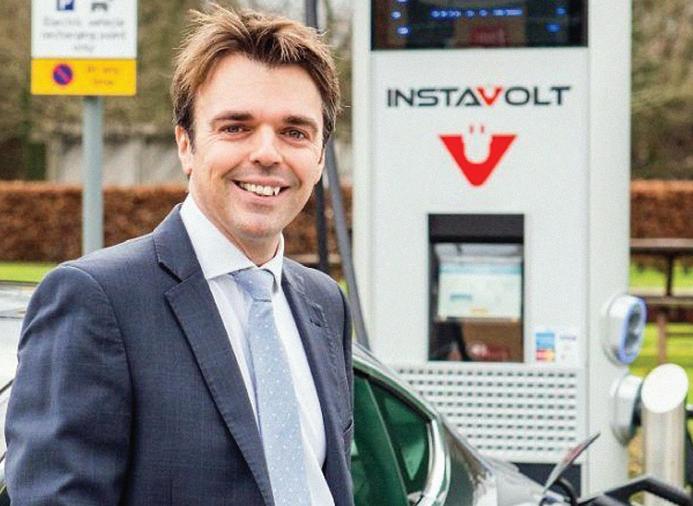
Adrian Keen, chief executive of InstaVolt said: “Electricity is by far our greatest cost, and the volatile energy market and record high inflation means we face no choice but to pass on some of these costs to consumers. We have tried to minimise how much we pass to consumers and absorb costs where possible. At this critical point in the mass transition to EV’s it is important that we continue to invest in building our network to give drivers confidence in public charging.
“We are on track to grow the number of chargers on the InstaVolt network by over 80% in the next 12 months. We’re building more hubs, and seeking to offer more
chargers at each location to serve a growing number of vehicles. We’ll also be expanding some of our busiest sites too, such as the recent expansion at Stroud Park, Oxfordshire just off the M40.”
When announcing the increase, InstaVolt highlighted the VAT disparity between home and public charging. Home energy tariffs attract just 5% VAT whilst public charging continues to attract a 20% rate of VAT, meaning drivers who cannot charge at home face higher bills.
“We continue to support the reduction in VAT rates for public charging, which currently stands at 20%, versus the at home tariff VAT of 5%, discriminating against those who don’t have access to home charging. We are raising awareness to align the rates of both public and private charging.”
The number of vehicles in the UK grew 0.4% to 40,506,971 in 2021, according to new Motorparc data released by the Society of Motor Manufacturers and Traders (SMMT), with more plug-in electric cars, vans, trucks and buses put on Britain’s roads amid highly challenging pandemic and economic conditions.
Despite the increase in the parc, major shortages of key components and supply chain disruptions across the globe caused new car registrations to remain static at 1.65 million, with car ownership falling –0.2% to 35,023,652 vehicles – the second year in a row the car parc has fallen and the first time the UK has experienced consecutive falls in more than a century.
Global shortages of components – most notably semiconductors – have constrained the new car market. Lockdowns of the past two years that closed dealerships also mean consumers have held on to their vehicles. These factors have contributed to the average car age reaching a record high of 8.7 years, more than a year older than that a decade ago. Around 8.4 million cars, just under a quarter of those on the road, are more than 13 years old, having been in service since 2008.
A good year for light commercial vehicles saw the number on the road rise by 4.3% to 4,804,833, contributed to an overall increase in the parc. The heavy goods vehicle sector, meanwhile, saw a 2.5% uplift, with 604,035 trucks in Britain making local, national and international deliveries amid increased demand from
key sectors. A decade of year-on-year decreases in the bus and coach parc ended with 1.1% growth last year to 74,451 units.
In contrast, the bus and coach parc remained at the second lowest level since records began in 1994, as lockdowns and pandemic-related changes in passenger behaviour saw reduced services and less demand from operators.
Electric vehicle ownership continues to grow rapidly. Nearly three-quarters of a million vehicles on the road today can be plugged in, including 720,053 cars, 26,990 vans, 993 buses and 313 trucks.
While electric car uptake is growing rapidly, accounting for around one-in-five new registrations, plug-ins still only represent around one in 50 cars on the road, demonstrating the scale of the challenge ahead in convincing every driver to make the switch. Meanwhile, there are some 20.5 million petrol cars and 13 million diesels making up 58.6% and 37.1% of the car parc respectively, a combined total of 95.7%.
In the commercial vehicle sector, some 0.6% of vans are now plug-in electric, indicating that this sector is around two years behind that of cars despite both vehicle classes having the same end-of-sale date for new petrol and diesel registrations. Zero-emission public transport is picking up pace, with 1.3% of buses and coaches now battery electric. But electric trucks account for less than 0.1% of the HGV parc, as development of zero-emission technology continues.
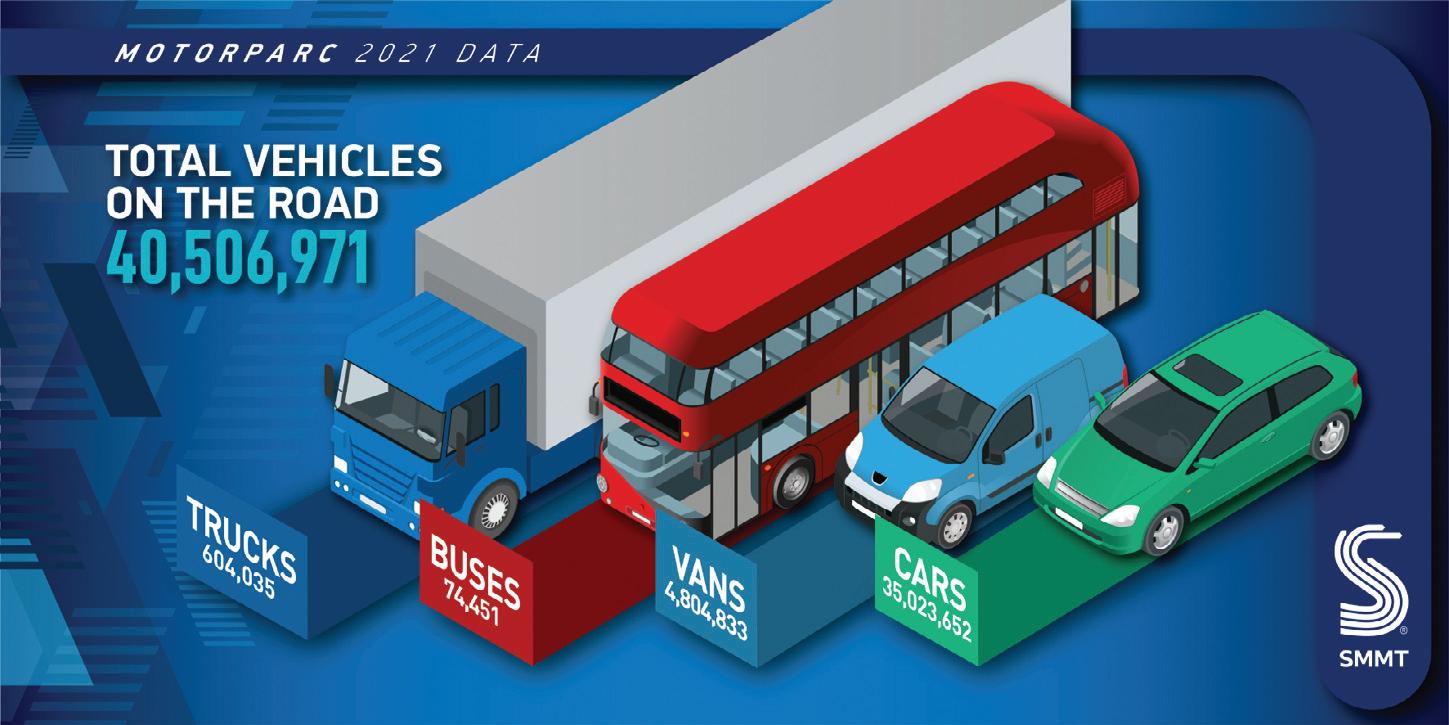
Electric car uptake also varies dramatically across the UK. A third (33.1%) of all plug-in cars are registered in London and the South East, representing 3.0% and 2.6% of all cars in each area. By contrast, 1.5% of cars in the West Midlands are plug-in electric, 1.9% in Yorkshire and Humberside, and 0.9% in the North East. Differences in uptake could also be seen across the four British nations, with plugins making up 2.2% of cars in England, 1.6% in Scotland, and 0.8% in Wales and Northern Ireland.
Nearly half (42%) of respondents would prefer their first car to be fully electric (26%) or in-part electric (16%), after passing their driving test, a survey commissioned by the Motor Ombudsman reveals.
YouGov polled nearly 500 existing and prospective learner drivers in Great Britain online.
The research found that male provisional licence holders are more likely than their female counterparts to want to adopt zero-emission motoring when starting their vehicle ownership journey (30% versus 23% respectively).
With electric cars sparking the most interest amongst the next generation of full driving licence holders, the study showed that just a fifth (21%) of those polled would want to get behind the wheel of a petrol-only variant once they had lost their L-plates, with just 6% of study participants saying they would opt for a diesel-engined vehicle once they passed. The remaining 30% of those quizzed stated that they did not know what kind of car would be their preference once they gained independence on the road.
30% of male drivers are likely to take up an EV
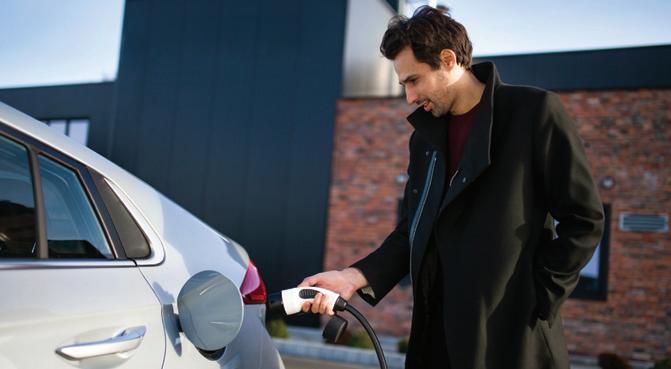
When questioned if they were aware that a car should be serviced at least once a year in line with the manufacturer’s recommended schedule, threequarters of respondents said that they were familiar with this important part of routine vehicle maintenance to help keep occupants and fellow road users safe. The results also showed that more females (79%) than males (71%), and those residing in the Midlands (83%) were the most up to speed with this
form of best practice to keep a car in a roadworthy condition.
On the subject of the need to get an MOT once a vehicle reaches three years of age, 77% of survey participants stated that they were conversant with this legal requirement. Awareness of having to hold a valid certificate for a used car from its third birthday onwards was revealed as being fairly balanced between male and females (75% and 80% respectively), with the survey also showing that knowledge about having to get a car tested was highest amongst individuals living in the South (85%). In contrast, awareness was lowest within the 18 to 24 age group (at only 73% of respondents in this category).
The survey findings have been published to mark the launch of The Motor Ombudsman’s Second Edition of its online #JustPassed guide. The free-ofcharge resource highlights the key considerations for new drivers when looking to purchase their first car, or when needing to get it serviced.
Three-quarters of a million EVs are now on UK roads, but car ownership falls
The Volkswagen Group has made a commitment to providing cost transparency across its electric vehicle charging networks.
The group’s volume brands Volkswagen, Cupra/Seat and Škoda are now offering simple tariffs for public charging, allowing their customers to charge at fixed kilowatt-hour prices throughout the entire charging network.
As part of its NEW AUTO strategy, the Volkswagen Group will be expanding its European charging network. E-car drivers can now use more than 310,000 charging points throughout Europe, including around 10,000 fast chargers at over 3,000 locations. Volkswagen is also planning a partner programme to increase driver comfort at charging parks.
Thomas Schmall, Volkswagen Group board member for technology and CEO of Volkswagen Group Components, said: “In the electric age, charging and energy are of the utmost strategic importance. For example, for many customers who consider an e-car, a home charging option is still a must. We cannot be satisfied with that limitation.
“With NEW AUTO, we have therefore taken these issues into our own hands and are ourselves investing in comfort, quality and expansion of the charging network on Volkswagen makes charging easier and more convenient on behalf of our customers. This is a strong team effort by our volume brands and the group! Our goal is to get everyone excited about e-mobility.”
Hildeard Wortmann, group board member for sales, added: “As part of the NEW AUTO strategy, we are working with our group brands towards the goal of becoming the market leader in e-mobility. To this end, we are building a complete ecosystem for our customers, which includes the key topic of charging. We want to offer a fully integrated,
comfortable and all-round positive charging experience that they won’t find anywhere else.”
Volkswagen customers will be offered a choice between three basic tariffs, each with fixed prices per kilowatt hour charged. The new tariffs apply to customers of We Charge (Volkswagen), Powerpass (Škoda), Easy Charging (Seat/Cupra) and the Elli EV charging brand. The tariff will offer top conditions for using IONITY fast chargers, among other benefits.
Volkswagen has developed a selected partner programme that involves working with charging hub operators. In the future, particularly convenient charging stations will be highlighted in the e-cars navigation system and drivers

Volkswagen and BP have launched a strategic partnership intended to boost the adoption of electric vehicles (EVs) across Europe by rapidly building a fast-charging network across Europe by 2024.
Volkswagen’s Flexpole 150kW charging units, each of which feature two chargepoints, have an integrated battery storage system, overcoming one of the biggest obstacles to the rapid roll-out of fast charging infrastructure in Europe today – the need for high-powered grid connections.

The Flexpole units can be directly connected to a low voltage grid which removes the requirement for a dedicated substation, reducing installation times. The Flexpoles provide fast charging speeds of up to 150kW2, enough to deliver up to 160km of driving in as little as 10 minutes, depending on the model of electric vehicle.
will be offered the option of choosing to drive there. The quality criteria will include reliability, weather protection and if there is a catering option. This means that customers will be able to target charging stations with a canopy and coffee offering. The programme is scheduled to start later this year.
Elke Temme, chief executive Volkswagen Group Charging (Elli), said: “We want to offer our customers an optimal charging experience, making the e-car an uncompromisingly first-time vehicle choice. For this reason, we are addressing the issues of price transparency, network expansion and charging comfort. With the selected partner programme, we will offer e-car drivers a quick and clear overview of the best charging options on their route.”
The company has also launched Plug&Charge, a function that will be activated later via a software update in all e-cars of the volume brands based on its MED (modular electric drive) architecture.
The vehicle identifies itself at the corresponding charging stations using the ISO 15118 standard and automatically starts the charging process. Plug&Charge is supported by IONITY, Aral/BP, E.ON and Iberdrola, among others. Other partners are already preparing to join the offer.
8,000 chargepoints could be available across Germany, the UK and other European countries.
Herbert Diess, Volkswagen’s chief executive officer, said: “The decarbonisation of Europe’s economy requires close collaboration across borders and sectors. We’re pleased to team up with BP to accelerate the rollout of the fast-charging network across Europe.”
BP is expanding its EV charging network, including at its extensive network of retail sites. Bernard Looney, BP’s chief executive officer, said: “EV charging is one of the key engines driving BP’s transformation to an integrated energy company..”
The first phase of the roll-out will see up to an additional 4,000 chargepoints at BP’s Aral retail sites in Germany and BP retail sites in the UK over the next 24 months. By the end of 2024, up to
The charger locations will be integrated into the navigation and other in-car apps of Volkswagen, Seat and Škoda vehicles as well as into Volkswagen’s charging application, Elli, making it easier for drivers to find available charging points. Any EV driver will be able to use the chargers as part of the BP pulse and Aral pulse network, enabling them to collect rewards from loyalty programmes.
Volume brands will offer charging at fixed pricesVolkswagen driver benefits include access to the IONITY charger network Bernard Looney and Herbert Diess launched the first BP/Aral Flexpole fast charger in Dusseldorf
More than half of van owners say they are discouraged from switching to an electric van due to a lack of chargepoint infrastructure, according to research published by the Society of Motor Manufacturers and Traders (SMMT). A survey of 500 van owners conducted for SMMT by Savanta ComRes found that 57% of people who own or lease a van in the UK are worried that they would not be able to find a public charging point when they need it.
Persuading van drivers to switch to zeroemission vehicles will be key to Britain becoming net zero, says the SMMT. “Vans directly support around one in 10 workers in Britain, acting as the essential workhorse for sectors such as construction and industry, trades such as plumbers, landscapers and cleaners, as well as home delivery services which grew rapidly during the pandemic.”
“With more than four million vans on the road, electrifying the fleet will substantially reduce the UK’s transportrelated carbon emissions, while also delivering cleaner air in cities. Those who switch can enjoy lower running costs, promote their environmental credentials and demonstrate sustainability when bidding for work,” says the SMMT.
More than a third of all new van models now on sale come with a plug following investment by manufacturers, investment which has delivered improved payloads and battery range. At the Commercial Vehicle Show, which took place at the NEC in Birmingham, around 10,000 visitors had the opportunity to discover the latest electric vans, alongside electric trucks, trailers and commercial vehicle technology. The survey suggests van drivers are happy with the vehicle ranges, with just 20% saying there is not enough variety of models to meet their needs.
Despite electric van uptake doubling in the last year, these vehicles still account for just one in 20 new van registrations –meaning the market is about two years behind that of cars, where uptake of zeroemission cars is closer to one-in-five. “With vans facing the same 2035 end-of-sale date for non-zero-emission vehicles as cars, however, the automotive sector is calling on all stakeholders to match its commitment to drive the electric transition,” continues the SMMT.
While just one-in-eight owners say they do not plan to ever switch to an electric
van, the vast majority (88%) say they would go electric by 2035, but a fifth of these owners say they will defer the decision for three to seven years. Overcoming this reticence is critical, says the SMMT, with many people (58%) suggesting they might be convinced to buy an EV sooner if there was a greater number of public charging points. The availability of government incentives such as reduced tax or grants towards purchase would also steer 57% of respondents towards a zero-emission van.
parking area. As a result, van charging provision must be factored into national infrastructure plans, with commensurate and binding targets for chargepoints for passenger cars and commercial vehicles to match the commitments of the automotive industry.”
While the survey reveals perceived battery capacity to be an influence on range anxiety, with 65% of respondents stating that longer battery range would encourage them to switch, these fears may be overstated, with an average range on a single charge of an electric van now around 150 miles. Just 6% of van owners say they exceeded this distance regularly, while four out of five averaged fewer than 100 miles in a single day.
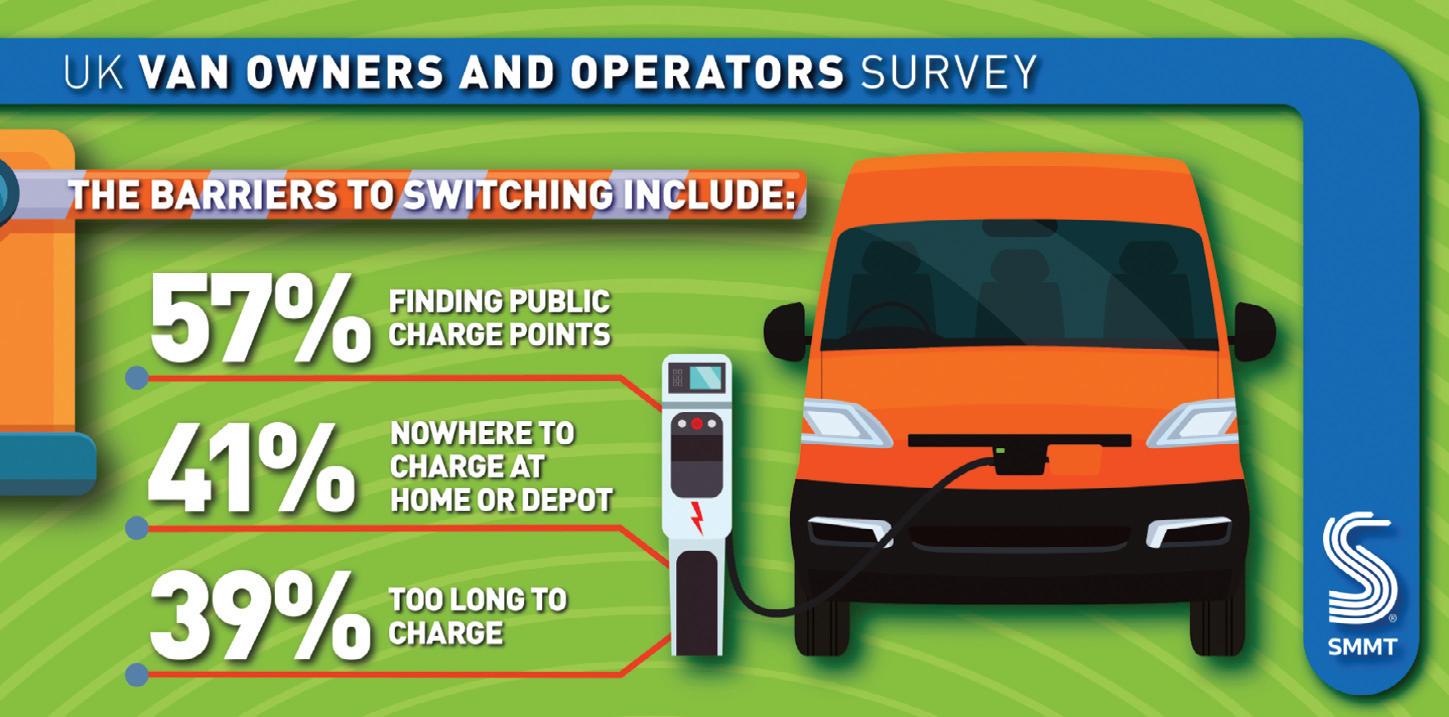
Electric van buyers currently benefit from the Plug-in Van Grant, worth up to £2,500 for small vans and £5,000 for larger ones, as well as up to £350 towards installing a chargepoint at their place of work. However, homeowners no longer receive a grant to install a home charging point, meaning van owners who operate from home will need to pay the full price, which can be up to £1,500. Given 41% of respondents said they had nowhere to charge a vehicle at home or their depot, supporting both private and public chargepoint provision will be essential to drive the switch, the SMMT argues.
“The UK already has a paucity of standard public chargepoints as take up of electrified vehicles accelerates,” says the SMMT. “There is just one available for every 32 plug-in vehicles on the road, with fears exacerbated for van owners. Public chargepoints designed for cars will not always be suitable or in the right locations for vans, which also typically need a larger
Mike Hawes, SMMT chief executive, observes: “Britain’s businesses run on vans and if we’re to deliver the nation’s carbon emission cuts, we need them to move to electric. There’s an electric van to suit every business case, but we need a ‘van plan’ to ensure zero-emission driving works for the millions of people for whom their van is their livelihood and the millions more who rely on these workhorses for the delivery of their daily needs. The automotive industry is getting these new technology vehicles into the showrooms – we need government and other stakeholders to match our commitments to get them out on the road.”
SMMT research shows 57% of van owners are anxious about going electric
We need a ‘van plan’ to ensure zero-emission driving works for the millions of people for whom their van is their livelihood
Chargepoint operator Liberty Charge is working in partnership with AppyWay, a data-driven kerbside management businesses.
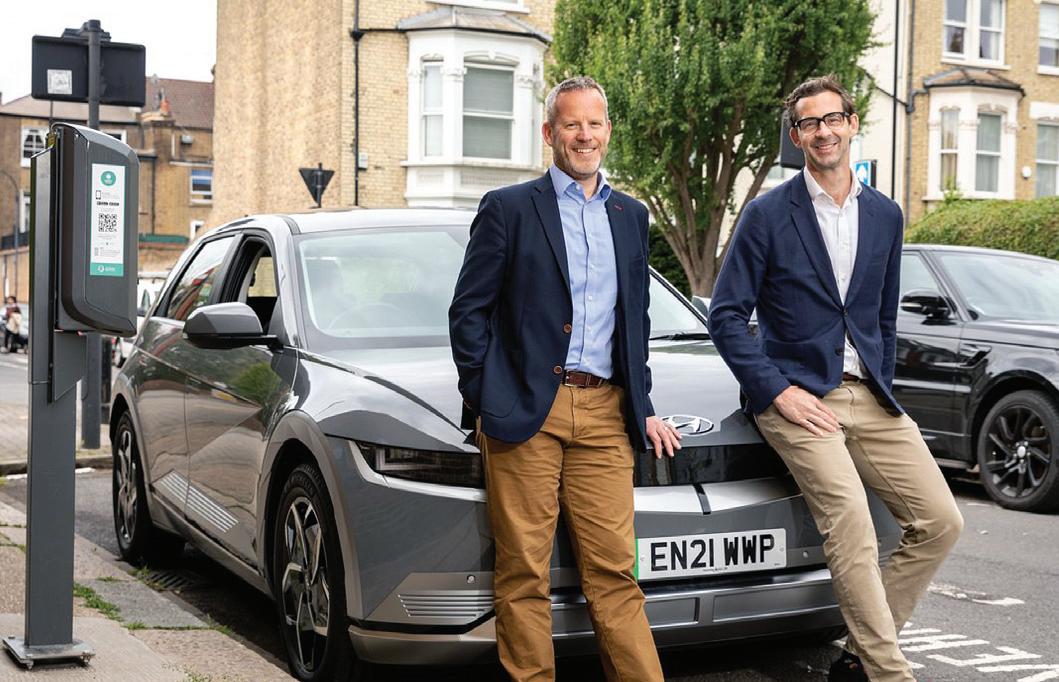
They are building a ‘park & charge’ solution that answers, via an app, the key questions every EV driver has: “Where can I park to charge? Is it available? How do I pay?”
The partners say they want to help support local authorities in improving the awareness of chargepoint availability for EV drivers.
Liberty Charge and AppyWay are building a park & charge solution that provides real-time space availability information to EV drivers while also helping local authorities with management tools to help them roll out EV chargepoints at scale.
Liberty Charge’s EV chargepoints will integrate with AppyWay’s kerbside management platform,
Tesla is allowing other electric vehicles to use its Supercharger network as part of a European pilot scheme. The pilot follows an announcement from Tesla chief Elon Musk that the proprietary Supercharger network would be opened to other brands.

The electric car maker has opened 15 of its 98 Supercharger stations in the UK to drivers of non-Tesla vehicles.
The sites are located at Aberystwyth, Adderstone, Aviemore, Banbury, Birmingham St Andrews, Cardiff, Dundee, Flint, Folkestone Eurotunnel, Grays, Manchester Trafford Centre, Thetford, Trumpington, Uxbridge and Wokingham.
utilising sensing technology and charging data to inform drivers when chargepoints are being used and when bays are being used solely for parking –otherwise known as ‘ICE-ing’.
The companies say the solution will address an issue that EV drivers have with current apps whereby, despite the apparent availability of a chargepoint, the adjacent parking bay is occupied.
AppyWay’s platform will enable councils to manage and monitor their EV charging
More than 2,500 rapid chargers are now available via Kia Charge, a service that gives Kia car owners access to more DC connectors in the UK than almost any other brand. DC charging allows electric vehicle owners to recharge quickly while en route to a destination.

Since April 2021, Kia Charge has seen its number of available rapid chargers grow by 33% in the UK from 1,951 connectors to 2,591. These include DC chargers of 50kW or more, as well as high-power charging stations that can recharge at up to 350kW.
The UK government recently announced a target of 300,000 public chargers to be available across the UK by 2030. As the UK’s public charging infrastructure grows exponentially, Kia Charge continues to offer Kia drivers
bays. The kerbside management tool will enable councils to plan, manage and track the changes needed for their traffic orders, the regulatory function that maps EV charging bays. This technology will be combined with a real-time demand system that provides granular data for on-street parking. When the platform is built, trials will precede a full launch. A reservation system for EV charging bays will be developed in the future.
Neil Isaacson, chief executive of Liberty Charge, said: “We have a fantastic opportunity to provide a frontrunning solution to what is becoming a significant issue as EV adoption increases. With our Liberty Global backing and partnership with Virgin Media O2, we can provide the scale and capacity required to roll this out across the UK at pace. We are passionate about helping local authorities support their residents in moving to more sustainable transport.”
Dan Hubert, founder and chief executive of AppyWay, said: “This partnership will harness the power of our entire platform, from supporting local authorities in the planning stages, to revolutionising the way EV drivers find and access charging at the touch of a button. With Liberty Charge we can help councils on their road to net zero by creating confidence in charging facilities and encouraging drivers to make the allimportant switch to EV.”
increasing visibility for green electricity demand on the market.
Kia Chargethe best access to the widest range of chargers from a single account.
Kia compensates all charging activity via Kia Charge with 100% renewable wind power. Kia purchases the equivalent number of megawatt-hours (mWh) used by customers from renewable sources, via Guarantee of Origin certificates, effectively flooding the grid with zeroemissions power and
The Kia Charge service provides access to chargers across all parts of the UK, Northern Ireland and Europe from a single account. In total, Kia Charge opens access to 21,123 connectors across the UK – equivalent to approximately 70% of the national public infrastructure – and more than 300,000 across 29 European countries.
In the UK, the service encompasses 23 chargepoint operators, including BP pulse, InstaVolt, Pod Point, Osprey and Shell Recharge. The service also offers access to the IONITY high-powered charging network. A single account gives access to all networks via a smartphone app (Android or iOS) or RFID card, with monthly invoicing.
Real-time data will benefit drivers and local authorities
Charge makes 2,500 rapids availableNeil Isaacson and Dan Hubert
Visa is working in partnership with JustPark’s community charging service, JustCharge, which enables electric vehicle owners with a private charger installed at their home or business premises to rent it out to other EV drivers when it is not in use via an app. Visa customers using the JustCharge service will receive rewards when paying by debit or credit card.
A Visa survey found that 95% of EV and hybrid drivers said standardised payment across public charging points would give them greater choice and accessibility.
Research by JustPark suggests that if just 5% of households with a home charger joined its community charging network this would double the number of charging locations available in the UK.
JustPark says enabling private homeowners to monetise periods when they are not using their charging point themselves would also help mitigate the loss of the government OZEZ (Office for Zero Emission Vehicles) EV charger installation grant, which ended in March.

JustCharge says it connects five million drivers with over 45,000 private driveways, parking spaces, garages and
Q-Park is working with EB Charging to roll out charging points across 80 sites in the UK and Ireland.
EB Charging will be responsible for the installation of the hardware and management of the charging provision, including a 24/7 customer support service.
Q-Park will invest over £3m in the UK and Ireland on a roll out of initially over 600 electric vehicle charging points across its estate of parking facilities. Installations will start in July 2022, with works including the modernisation of the existing charging infrastructure.
Adam Bidder, managing director of Q-Park UK and Ireland, said: “The world is changing and we’re happy to contribute with our portfolio and operations to the new environment we are in. We lead the way on EV charging in the private parking sector. Even so, we undertook a lengthy consultation process to ensure that we found the correct strategic partner to add value to our existing parking and charging proposition.”
other locations every year. Mike Strahlman, director of EV at JustPark said: “We must collectively find solutions to help millions of British households transition to clean-air vehicles. While EV demand is growing dramatically, public charging infrastructure is falling significantly behind. Unlocking thousands of home chargers during the 90% of the day they are not in use makes EV adoption a possibility for more than 50% of British households without access to designated off-street parking. This partnership with Visa is a landmark moment in our efforts to redress the
balance and make EV adoption an effortless, viable and cost-effective solution for millions more UK drivers.”
Charlotte Hogg, chief executive of Visa Europe said: “The challenge we collectively face is to grow our electric vehicle charging infrastructure rapidly and strategically, and find sustainable solutions today to avoid creating problems for the future. Innovative solutions like JustCharge, which provides secure, managed public access to private charging points, can make an immense contribution to overall EV charging provision.”
The entry Easycharge tariff starts at £30 per month for 1,500kWh (est. 6000mls), rising to Easycharge Plus at £45 per month for 3,000kWh (12,000mls) and then to the Easycharge Unlimited tariff at £85 per month.
Jersey Electricity will offer EV drivers a bundled subscription that will give hassle-free home charging plus an Ohme Home Pro charger from £30 a month. The Easycharge subscription packages offer customers an Ohme Home Pro smart charger with a lifetime warranty, access to the Ohme
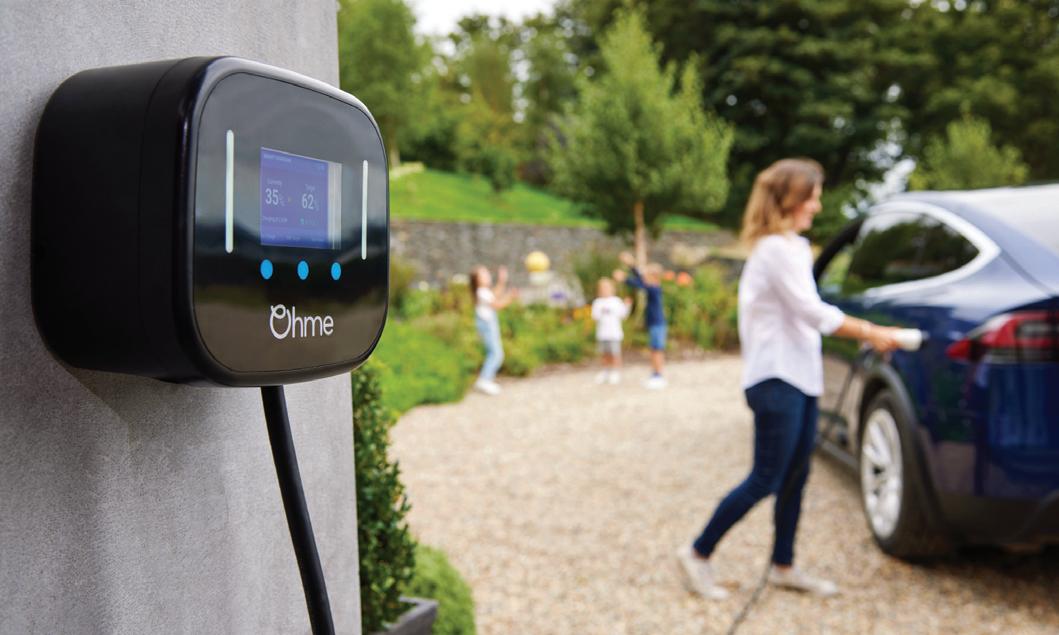
smart charging app, full installation, ongoing customer support and inclusive overnight charging.
The three tariffs on offer with Easycharge will provide an all-inclusive package for customer peace-of-mind, each lasting for three years on a rolling subscription.
“We are delighted to be linking with Ohme to deliver a brand new electric vehicle charging solution for Jersey,” said Peter Cadiou, director of commercial services at Jersey Electricity. “Easycharge is a unique solution for drivers to package all of their EV charging costs and make them more manageable via a convenient monthly subscription. We have listened to customer feedback and are really excited to bring this first of its kind solution to benefit customers in Jersey, enabling them to easily make the transition to EV driving.”
Portable EV charging developer ZipCharge has announced strategic partnerships with ICEE Managed Services and Graphite to develop the mechanical and electrical systems for the GoHub.
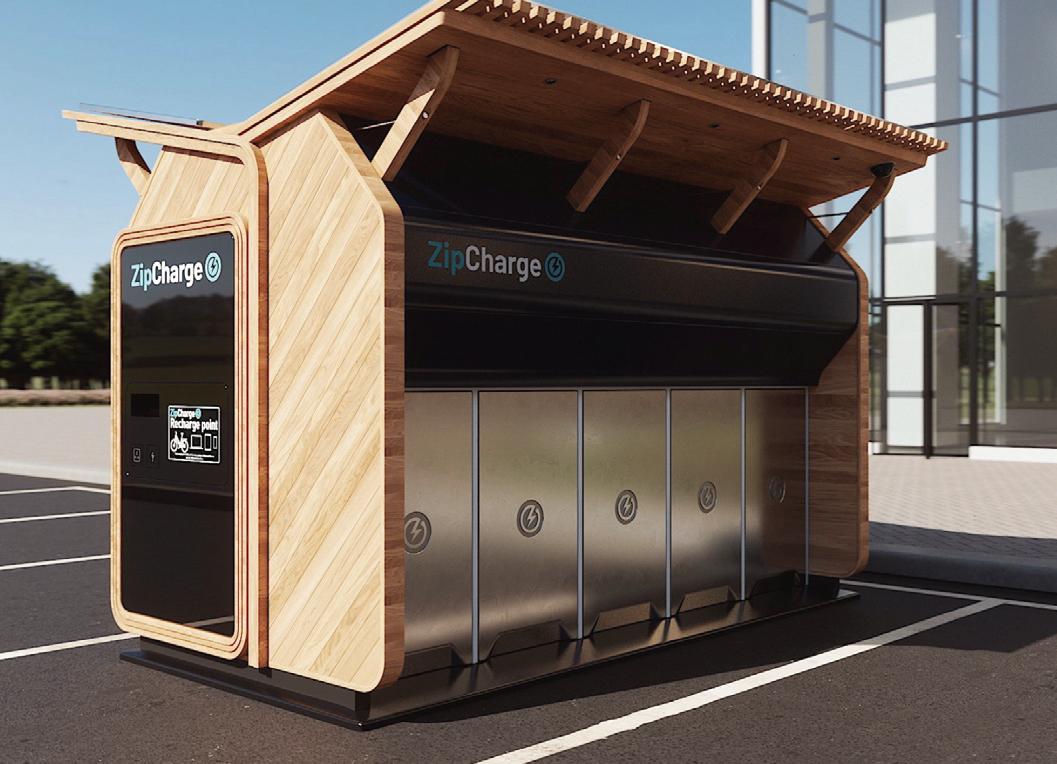
The GoHub is a modular and flexible storage unit for Go portable chargers. It is intended for use in a range of locations, including on-street, car parks, workplace and private environments.
UK-based ZipCharge is planning a global energy point network of 100,000 GoHubs by 2030.
British companies ICEE Managed Services and Graphite will be the key partners in bringing development, production and delivering the GoHub to market. Both companies have been involved engineering, manufacturing and installation of public infrastructure, including the Brompton Bike Hire docks at 60 locations across the UK.
Jonathan Carrier, ZipCharge
co-founder, said: “We are delighted to have found two strategic partners in ICEE and Graphite. Together we will deliver the GoHub, a revolution in public charging provision, providing a community-based solution that can be installed anywhere, at a much lower cost and at a much faster rate, while enabling any parking space to be a charging spot.
“The ability to roll out electric vehicle charging infrastructure at speed is essential to allow national and local governments to deploy it
New British company EVIOS has launched an electric vehicle (EV) home charger. Created by David Martell, former chief executive of Chargemaster, the EVIOS One features a jargon-free user interface, a large colour screen and a smartphone app that allow users to configure each charge to suit their needs and preferences. This enables users to see exactly how many miles have been added in each charging session and the cost.
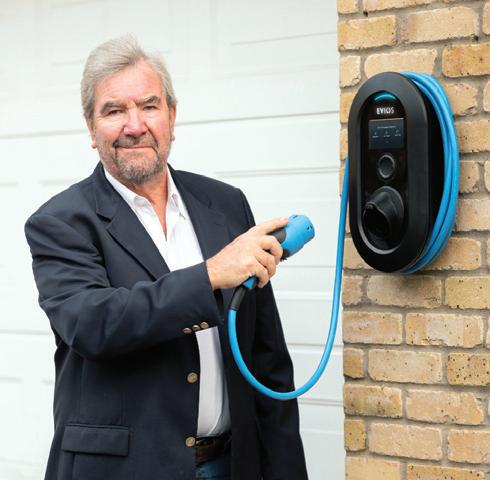
The EVIOS One can integrate with home energy tariffs to charge during off-peak times to significantly reduce running costs, and it can be paid for via interest-free monthly instalments. There is also an all-inclusive package that includes the cost of installation.
The EVIOS One can support separate user profiles, making it an option for shared residential and business parking areas, or homes with more than one EV. Access to the EVIOS One is
protected via PIN to prevent unauthorised use. Up to eight profiles can be stored. The EVIOS One is internet-enabled. Via the app, users can access and control charging when away from the unit itself. ‘Push’ notifications sent via the app or email mean users can be kept updated on key details relating to their charges.
In addition, over-the-air updates ensure users always have access to
at a faster rate where it is needed the most to support mass EV adoption. EV owners will now have the choice to purchase the Go outright, on subscription or rent one through the GoHub. The GoHub is the world’s first portable EV charging infrastructure for shared, public use.”
Working together with ZipCharge, ICEE and Graphite undertook a three-month concept study to evaluate the design, technical, operational and installation challenges of the early GoHub concept.
Using lessons learnt from other projects, the team could accelerate their understanding of the technical challenges associated with both the mechanical design and electrical systems.
During 2022, ICEE undertook detailed engineering design work on a range of GoHub configuration. It focussed on delivering a modular solution that could maximise the number of Go powerbanks available in the smallest possible footprint to reduce material cost, simplify manufacturing, and make it easier to transport and install.
Graphite previously developed the electronics and software to operate and manage the hire of Brompton’s folding bicycle lockers. Graphite designed bespoke Linux-based controllers and modems with ultra-low power consumption to reflect the fact that most Brompton docks run off solar power. As well as the controller, Graphite developed the system for identifying in which dock and bay each individual bike is located in throughout the UK, which is how the ZipCharge Go powerbanks will be monitored inside the GoHub.
the most up-to-date functionality and features. The EVIOS One can connect with Amazon Alexa and Google Home devices, allowing users to adjust settings and review charge status via voice commands.
Owners and users of the EVIOS chargepoint can download detailed reports outlining their energy use and expenditure – tailored for time periods of their choosing – to help keep a track of outgoings.
Meanwhile, business users can easily generate summaries for expense claims based on individual users or individual vehicles – ideal if there are different EVs being run by the same household.
Drivers keen to minimise the environmental impact of their motoring can select the EVIOS One’s ‘Pure Green’ setting, which interacts with solar or wind power sources attached to the home to deliver zeroemissions charges.
The new home charger is designed, manufactured and shipped from a new purpose-built production facility
in Stewartby, Bedfordshire. The EVIOS One installation is undertaken by the company’s own team of qualified installers around the UK. New customers can book an installation via the EVIOS website.
EVIOS is the brainchild of David Martell, who was founder of Chargemaster, which went on to be acquired by BP in 2018. Martell was also an advisor on EV infrastructure to the Department for Transport from 1995 to 2000.
“For EVs to be adopted by millions more UK motorists, they should be at least as easy to own and run as ICE vehicles,” Martell said. “Much attention is given to developing the quality and quantity of public chargepoints, but the majority of charging will need to take place at homes.
“We evaluated all of the existing home chargers on the market and saw that too often they are hard to understand and control, and we believe this will put many off the idea of buying an EV in the first place.”
ZipCharge teams up with designers at ICEE and GraphiteDavid Martell
Apop-up mini solar car park and electric vehicle charging hub, deployable in just 24 hours, has been revealed at Surrey Research Park in Guildford. The Papilio3 has been developed by 3ti to meet the UK’s need to expand electric vehicle (EV) infrastructure ahead of the government’s proposed ban on the sale of new diesel and petrol vehicles in 2030. 3ti is a UK designer, installer, funder and operator of solar car parks.
The unit is built around a recycled shipping container and can support up to 12 fast EV chargepoints. The solar and battery-boosted charging system optimises the speed of charge and reduces the carbon intensity of electricity used.
The Papilio3 solar hub is available from 3ti on a rental contract so requires no capital investment by customers.
“Overnight charging at home generally provides the most cost effective, carbon efficient, sustainable form of EV charging, but in the UK, around 50% of households will not be able to do this,” says Tim Evans, 3ti founder and chief executive. “If you live in a flat, a tower block, a rented house, in temporary accommodation or even in a £10m terraced town house in Chelsea, you’re probably not going to be able to charge an EV at home.
“We believe that solar and battery boosted destination and workplace charging will become the best EV charging solution for drivers, irrespective of the type of home they live in. By utilising dwell times of several hours, when cars are parked at work or when the driver is visiting a shopping or leisure venue, for example, 3ti’s system ensures that EVs can achieve a level of charge that covers day-today driving needs in the most low carbon way.”
Papilio3 is fitted with three modular canopies that support 36 solar panels and has battery storage capacity of up to 250kWh. It has been developed by 3ti with Cambridge Design Partners, and has been designed for roll out at workplaces and public destinations such as hospitals, hotels, meeting venues, sports or shopping centres, tourist attractions and town centres. Each unit offers sheltered, illuminated and secure parking, plus a convenient, available and reliable EV charging experience that supports a mixture of 7, 11 and 22 kilowatts.
“Widespread adoption of solar car parks will turn underutilised spaces into renewable energy generating assets, and adding batteries and EV chargepoints will accelerate decarbonisation of the UK’s transport sector,” explains Evans, who led the teams responsible for solar car parks at Bentley Motors in Crewe and JP Morgan in Bournemouth.
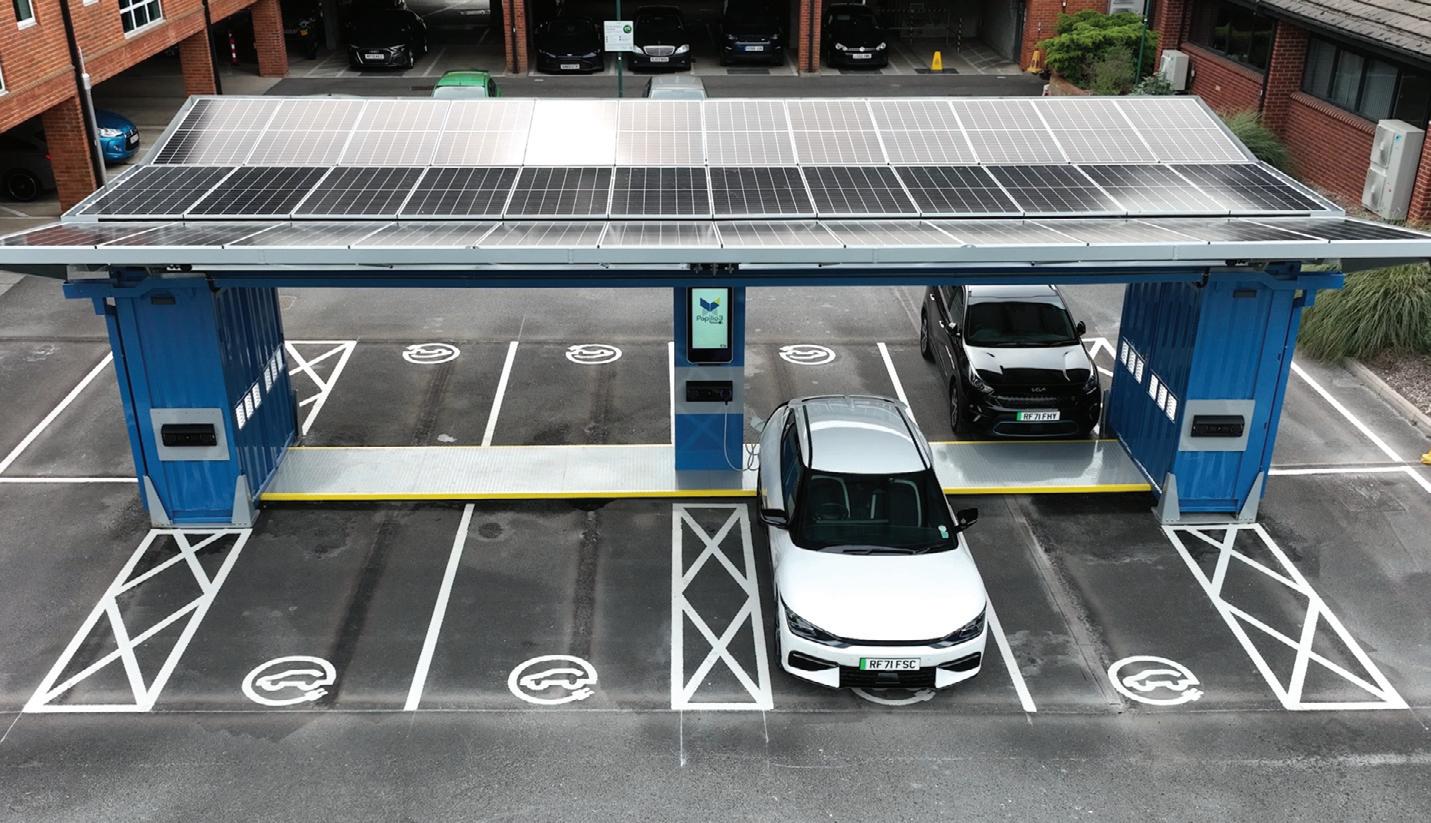
“Allowing businesses to generate renewable energy right outside their front door not only gives them greater control of energy costs, it also makes a huge statement to customers and visitors that they are serious about tackling climate change and reducing carbon emissions. By deploying fast chargepoints, up to 12 at a time, with Papilio3, we will provide much needed, cost effective chargepoint infrastructure and expand the UK’s network of public EV chargepoints.”
Papilio3 integrates three technologies that are more usually considered individually: solar photovoltaic electricity generation, battery energy storage systems (BESS) and EV chargepoints. Combining the three offers a range of benefits, including the ability to use grid energy, solar power and battery storage to optimise the speed and carbon intensity of EV charging. On-site renewable energy generation from solar panels also reduces energy costs and gives businesses greater control over energy supply.
The Surrey Research Park is home to over 200 innovative businesses, from start-ups to global corporates such as Airbus and BAE Systems. Owned by the University of Surrey, the research park’s businesses employ over 4,500 staff.
It was 3ti’s preferred locational choice
because of the park’s client base, the presence of a cluster of companies working on sustainability and the deep links with the University of Surrey.
Grant Bourhill, chief executive officer at Surrey Research Park, said: “The University of Surrey and Surrey Research Park have a long history of working with industry to drive innovation. We pride ourselves on creating an environment that supports the entrepreneurial community to develop and grow. The roll-out of Papilio3 reflects our commitment to sustainability in addition to testing new innovation and supporting business growth.”
“One of the best things about owning an EV is that you don’t have to visit a petrol station to fill up,” says 3ti chief technical officer Mark Potter. “As EV drivers, we want to charge when we stop, not stop to charge. Rapid charging with 50-250kW is fine for en route charging during long journeys, but it’s not the right solution for regular use – it increases battery degradation and pushes up electricity prices for everyone, not just those who are charging. If you can’t charge at home, it’s best to charge when you arrive at where you’re going.
“Cars are parked 95% of the time. That’s when and where they should be charged. Destination and workplace charging is a more sustainable option, better value and more much more convenient. The three technologies integrated in Papilio3 enable the system to store and use the cleanest, lowest cost energy from its own solar panels and the grid supply. That means we can reduce the demand on peak hours grid energy without compromising EV charging speed.”
3ti launches a pop-up solar car park that can power electric vehicle chargers

























Stand-up Kerry Godliman will be the special guest host of the British Parking Awards 2022
The British Parking Awards is a celebration of excellence and achievement by individuals, teams and organisations. The winners are revealed at a 4-star gala lunch that will be held in London on 16 September. The series of celebrity hosts who have compered the event is one of the main reasons that over the past 20 years the event has become the highlight of the sector’s social calendar.
Recent years have seen us entertained by the likes of Shaparak Khorsandi, Dr Xand van Tulleken, Hal Cruttenden and Lucy Porter.
We are excited to announce that this year’s ceremony will be compered by the brilliant Kerry Godliman. Charmingly straight-talking and quick-witted, Kerry is one of the country’s best performers.

Kerry is best known for her TV appearances on Mock The Week, Live At The Apollo, Michael McIntyre’s Big Show, Taskmaster, Hypothetical, Ultimate Worrier, The Jonathan Ross Show and 8 Out Of 10 Cats
She is a regular on BBC Radio 4, where she has appeared on the esteemed News Quiz, The Now Show and Just A Minute, as well as her own series, Kerry’s List. She also starred in the hit series The Wilson Save The World alongside Marcus Brigstocke, our 2021 awards host.
Kerry is also an accomplished actress. Her roles include Derek, Bad Move, Save Me, Carter’s Get Rich, Call The Midwife and Mascots, as well as starring alongside Ricky Gervais in the hit Netflix series After Life Proving the breadth of her acting range, Kerry also starred in the BBC military drama Our Girl and on stage in the National Theatre’s exploration of immigration, England People Very Nice
The 20th anniversary British Parking Awards take place at the Royal Lancaster London on 16 September 2022.
www.britishparkingawards.co.uk
 Kerry Godliman
Kerry Godliman





Innovations and improved enforcement are helping Snowdonia National Park to cope with this summer’s influx of visitors.
Words and pictures by Rhodri Clark
Transport planners and politicians often talk about using carrots and sticks to bring about modal shift, but rarely is that approach so clearly visible on the ground as it is now in Snowdonia National Park.
Bus services to the most popular places have never been as frequent as this summer, while changes to parking controls have reduced the problems caused by illegally parked cars.
The improvements follow a review commissioned in 2020 by Partneriaeth Yr Wyddfa, a partnership of organisations and landowners which are responsible for management of Snowdon (Yr Wyddfa), Wales’ highest mountain. Their activities include conservation, upkeep of footpaths, farming and mountain rescue. The review recommended developing a sustainable tourism approach to reduce the problems of tourism and increase the benefits to local communities, while improving the visitor experience and enabling a more diverse range of visitors to enjoy the area.
At the root of the problem is the proximity of the highest mountains in the northern part of the national park to the A55 Expressway from Chester. Pen-y-Pass, one of the most popular starting points for walking up Snowdon, is 14 miles from the Junction 11 of the A55. Llyn Ogwen lake, another “honeypot”, is only seven miles from the A55 along Thomas Telford’s expertly engineered A5.

With the northern part of the park receiving almost five million visitors each year before the pandemic, parking has been a thorny issue for decades. In the late 1990s, the local authorities drew up plans for enhanced bus services funded by a £4 charge for parking in gateway car parks. Some new car parks were installed and a survey found that 80% of motorists
supported the plan, but the idea was dropped in 2002 after opposition from some quarters.
Roadside parking continued to be a blot on the landscape –visible from afar when sunshine glinted on cars. It forced pedestrians in some places to share the carriageway with traffic legally entitled to travel at 60mph.
Matters came to a head in summer 2020, when there was a surge in visitors to Snowdonia following the long period of restrictions in the first COVID-19 lockdown. Instead of five million trips being spread across spring, summer and autumn, now the visitors seemed to head for the hills in the same few weeks. Images of police towing away visitors’ cars made national news.
The news coverage did not reflect well on Wales, although it was not representative of Welsh tourism locations as a whole. The Welsh Government was spurred into action. Having withdrawn its funding for the Snowdon Sherpa buses in 2009, it now decided to devote financial resources to tackling the problems, via its arm’s length Transport for Wales company.
It is providing 43% of this year’s funding for the Sherpa network, including capital funding for enhanced bus stops and new branding from Best Impressions. The network is now known only by its Welsh name, Sherpa’r Wyddfa. Buses run every hour on the three main routes, overlapping to increase frequency along key sections of road.
On peak days, an additional shuttle bus connects the Nant Peris car park with Pen-y-Pass to give motorists a bus every quarter of an hour – a frequency normally associated with urban park & ride.

The national park authority introduced a pre-pay system for the small car park at Pen-y-Pass last year, to encourage a shift of mindset. This measure challenges people’s expectations of being able to drive directly into the most sensitive environments and leaving their cars there. Communications officer Ioan Gwilym says the system is working well. That and other measures “have virtually wiped out any illegal parking”.
He acknowledges, however, that illegal parking has been continuing in 2022 in the Ogwen Valley. The national speed limit
has been replaced by a temporary 40mph limit alongside Llyn Ogwen, where there are toilets, a youth hostel, café and small short-stay car park. Police towed away some vehicles on the Easter bank holiday weekend.
One A5 layby beside Llyn Ogwen has been taken out of use this year. The authorities and local community are encouraging visitors to park at Bethesda, north of the park boundary, and catch the TrawsCymru T10 bus into the national park. This twohourly service, funded by the Welsh Government, has replaced an infrequent Sherpa bus.
In the Ogwen area and other key locations, clearway restrictions are reinforced by yellow North Wales Police warning signs showing vehicles being towed away. This year, however, any towing away may be performed by Gwynedd Council, which adopted powers to undertake this activity last August.
“Perhaps this is making motorists think twice before deciding where to park,” says Ceri Hughes Thomas, the council’s parking and street works manager. “The council’s parking enforcement officers aim to monitor regularly the locations which have proved problematic in the past in terms of illegal parking, such as Pen-y-Pass, Y Glyn, Llanberis and Ogwen.
“Feedback from officers so far suggests that most motorists are conforming to the parking restrictions. No major difficulties have been reported, apart from irresponsible parking in Ogwen. Perhaps it’s premature to think that the problems have been solved, but certainly the situation is better so far this year.”
She says the section of the A5 east of Ogwen Cottage, which is in neighbouring Conwy county, is full to the brim because there are relatively few restrictions, while on the Gwynedd side –north of Llyn Ogwen – there have been problems with motorists parking beyond the limit of the double yellow lines.
That location can be particularly problematic when motorists park alongside the solid white line in the centre of the A5 where bends around cliffs limit forward visibility for drivers. Cars parked at the roadside force drivers to cross the white line, on a road where the national speed limit applies. Parking has also caused problems in the last two years in less famous beauty spots where the number of cars is much lower but enough to overwhelm the basic rural infrastructure. For example, at Llyn Geirionydd, a beautiful upland lake west of the Conwy Valley, a
country lane is now signed as a clearway for one mile.
The national park authority has increased the charge for parking at Pen-y-Pass from £10 to £18 for eight hours –unusually high for a rural area. However, there is no shortage of visitors willing to pay the premium price. Spaces have to be booked via JustPark no later than four hours before arrival.
This year the car parks around Snowdon will also be monitored with new sensor technology which will convey occupancy data in real-time to visitors, encouraging them to make “smarter decisions”.

Dana Williams, the national park’s sustainable tourism officer, says the aim is to make this data available to the public from this summer.
The authority has chosen not to increase parking charges at its other car parks, because it wants to encourage people to park & ride in places like Nant Peris and Llanberis rather than continue in their cars into the heart of the national park.
Its longer term plans include encouraging more visitors to catch the train to North Wales, instead of driving. Bangor station, served by trains from Chester and London, now has direct buses to Pen-y-Pass and Ogwen.
The Conwy Valley line from Llandudno Junction provides access to the north-eastern edge of Snowdonia, including Betws-y-Coed, and the Cambrian Coast line from Machynlleth to Pwllheli serves the western edge.
Another element of the strategy to alleviate parking pressures is to encourage more people to visit other parts of the national park. In the last two years people have been queuing for the last few metres up to Snowdon/Yr Wyddfa’s summit while the paths are much quieter on dramatic peaks such as Moel Siabod and Cader Idris.
“We’ve got a list of promoted routes on our website,” says Ioan Gwilym. “We’re trying to promote routes that receive less attention on our social media as well.”
The authority is also highlighting the park’s attractiveness at quieter times of the year, partly with the aim of spreading the load more evenly. “Snowdonia is one of the nicest places to be in September and October,” says Gwilym. “We’re not encouraging people to go up the mountains in winter, because of the weather and conditions underfoot, but the park has lots of other interesting places for walking and visiting.”

The national park authority introduced a pre-pay system for the Pen-y-Pass car park to encourage a shift in mindset Ioan GwilymALL PHOTOGRAPHS RHODRI CLARK



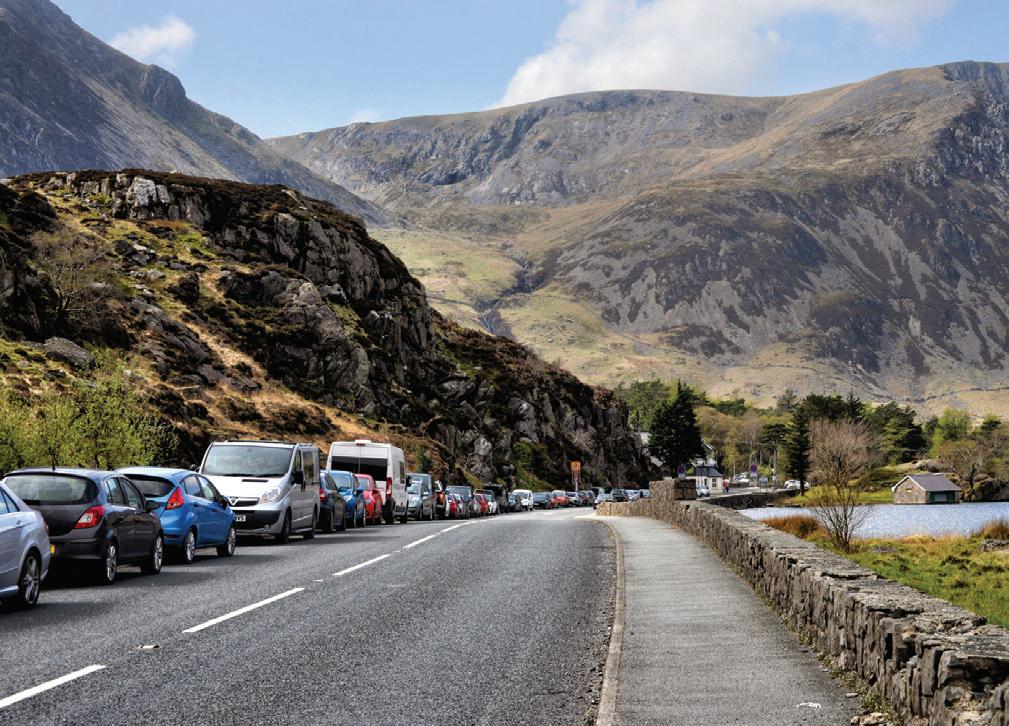









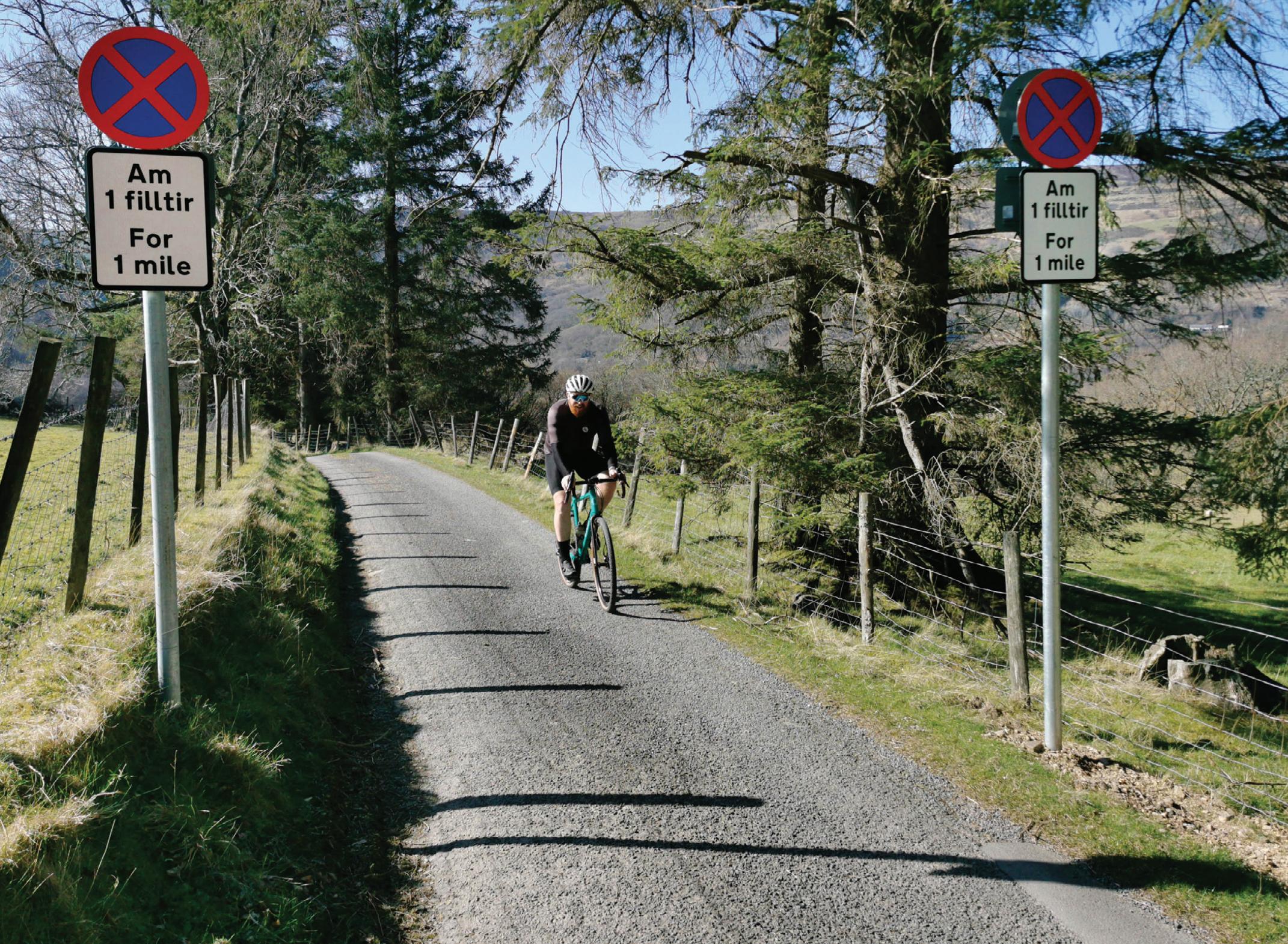


In a previous article I discussed the complexity associated with managing warnings in relation to tolling and moving traffic. But this is not specific to moving traffic – the reality is that the world of parking and enforcement is becoming increasingly complex by the day. Between tolling, Clean Air Zones, moving traffic, permits and all the many other elements, the requirement to effectively manage road space is only increasing. To illustrate, just look at London, where the recently extended ULEZ (Ultra Low Emission Zone) was in operation for just five months before Mayor of London Sadiq Khan announced that further expansion was required.
Continually increasing enforcement requirements will drive ever greater numbers of transactions through parking platforms. But legacy technology infrastructures are simply not able to manage the load. Despite being a ‘techy’ myself, I understand that technology infrastructure can be confusing and is probably not very exciting for most people – but it is vital to be aware of.
Over the coming years we will see a requirement for councils to transition to ‘True Cloud’ or ‘Platform as a Service’ infrastructures for their enforcement solutions. This will present significant challenges for authorities and technology suppliers – but there are major benefits to be realised too, as this article outlines.
At Taranto we began addressing this infrastructure issue back in 2018. We reviewed our technology and saw issues on the horizon in relation to delivery, support and security – all of which would
impact not only our business, but also our clients’ ability to manage their operations, serve their customers, and enforce penalty charge notices (PCNs).
Around this time, we were also in the early stages of considering the requirements for the ULEZ expansion, which eventually launched in October 2021. Our technology was processing around 7,000 PCNs per day, but it was apparent that it would need to scale to handle two or three times as many – and perhaps even 10 times the volume during peaks.
Would the technology infrastructures currently used in the industry cope? There was no chance.

Scale is one challenge, but we also saw a growing requirement for flexibility too. With any enforcement implementation there is always a likelihood of higher levels of PCNs during the first few months, as motorists adapt to the new environment.
We therefore understood that our technology infrastructure would need to be able to not only accommodate greater scale, but also to have the ability to flex in line with shifting requirements. In this way we would enable our customers to adapt to any unforeseen future changes – the requirement for which has been made very clear through the turbulence and upheaval we have all experienced through the past two years.
Our considerations with respect to the expansion of ULEZ crystalised our view that we needed to fully embrace the potential in Cloud technology. We chose to adopt what I like to call a ‘True
Barry Johnson from Taranto Systems explains why increasing complexity and PCN volumes are driving an urgent need to embrace ‘True Cloud’ solutions
Taranto’s technology was processing around 7,000 PCNs per day, but it was apparent that it would need to scale to handle two or three times as many – and perhaps even 10 times the volume during peaks
Barry Johnson
Cloud’ platform service – or Platform as a Service (PaaS) –because it offered a framework upon which we could build our applications, with all servers, storage, and networking managed by a third-party provider – in our case Microsoft Azure.
At this stage it is important to differentiate between the PaaS approach and other forms of hosted delivery, which would not offer the same level of benefits. Indeed, one potential ‘stop gap’ –moving to an Infrastructure as a Service (IaaS) model – was rejected during our ‘discovery’ phase as, while it may have been less challenging to transition to, ultimately, it would not enable us to take full advantage of the many benefits offered by PaaS.
As the next section outlines, a full transition to the Cloud would be the foundation for a sea change in terms of quality, scalability, availability, resilience, management and security.
Though the transition was a challenge for all involved, the decision was a simple one: we had to do it if we were to support our clients in managing the future demands of their operations.
I mentioned the scale and flexibility benefits earlier, but what about organisations that may not need anything like the scale that London does?
While few organisations will issue and process so many PCNs, scope of operations is increasing in many councils. Many more authorities in England will be granted powers to enforce moving traffic, while Low Emission Zones, Clean Air Zones and Low Traffic Neighbourhoods are increasingly common. All such schemes will increase both the volume of PCNs and complexity of operations. As a result, authorities of all sizes will soon find that technology infrastructure is something they need to consider. At the same time, it is worth noting that councils managing fewer PCNs also tend to have smaller teams, so are less well equipped to manage workplace challenges.
As the adjacent panel outlines in more detail, all councils will benefit from a True Cloud approach because it will enable them to make efficient use of their team’s time; access powerful new functionality quickly, easily and without disruption; and enjoy far greater system resilience and security.
Our world is becoming ever more complex, and technology continually grows to make it manageable. But one thing that is not expanding is space for roads – so the only option is to make better use of what we have. This means the requirement for enforcement tools will only increase – but keeping up requires a radical overhaul of technology infrastructures. It may not be exciting, but it is both important and urgent.
My advice is not to wait: start thinking about technology infrastructure now. And when you decide it is time to act, embrace True Cloud technology in the form of Platform as a Service.

Detailed reasons to embrace Platform as a Service which will be applicable to councils of all sizes
Many readers will be aware that upgrades are often painful, time-consuming and prone to costly errors. Platform as a Service auto-deployment simplifies the entire process and reduces associated risk. In practice, we have seen upgrades which might previously have taken hours reduced to minutes.
Streamlining upgrades removes a barrier between customers and powerful new functionality. Easier upgrades can be undertaken more often, ensuring new features reach customers sooner, and breaking down training into manageable, bite-sized chunks. Additionally, by adopting Microsoft’s Azure, we have been able to access Azure Applications, which makes it easy to enhance our solutions by utilising and integrating a range of off-the-shelf functionality, all of which is reliable, secure, and maintained by Microsoft.
Simpler upgrade processes result in a significant reduction in the burden of User Acceptance Testing (UAT) on customers. With Platform as a Service, UAT sessions are split into smaller, more manageable chunks of work leading to less operational disruption.
Platform as a Service delivers efficiency benefits for councils and suppliers such as Taranto. I have already covered time savings in relation to upgrades and testing, but consider also maintenance and support. With PaaS, nobody at Taranto is required to look after operating systems, security or servers – all are managed remotely by Microsoft, using dedicated, specialist resources and tools. This enables our staff to focus on supporting our customers in meeting their obligations.
Resilience and security Security is a huge concern for our clients, given the requirement to handle so much public data. Platform as a Service manages this area ‘off the shelf’ through Microsoft’s standard security and resilience packages – which greatly reduces the risk associated with on-premise hosting. Put simply: a PaaS solution is the safest option when it comes to security and resilience of data.
Application insights
Platform as a Service has made it possible to leverage Microsoft Insights, a Performance Management service. This functionality enables our team to proactively monitor trends, and continuously improve system performance and usability, leading to a slicker system and operational efficiencies for our clients. Additionally, the system can alert the support team whenever an error occurs – making it possible to proactively address issues and ensuring that potentially costly faults do not go unnoticed.
Barry Johnson is senior technical director at Taranto Systems. Having begun writing software as a teenager, in 2000 he and a group of colleagues formed a business called Traffic Support Limited, which focussed on developing parking enforcement software. Today he leads a team of more than 25 software developers focussed on delivering innovative technology solutions that support the enforcement and management of parking and traffic violations, parking permits, civil enforcement, clamping and removal, and more. tarantosystems.com This article

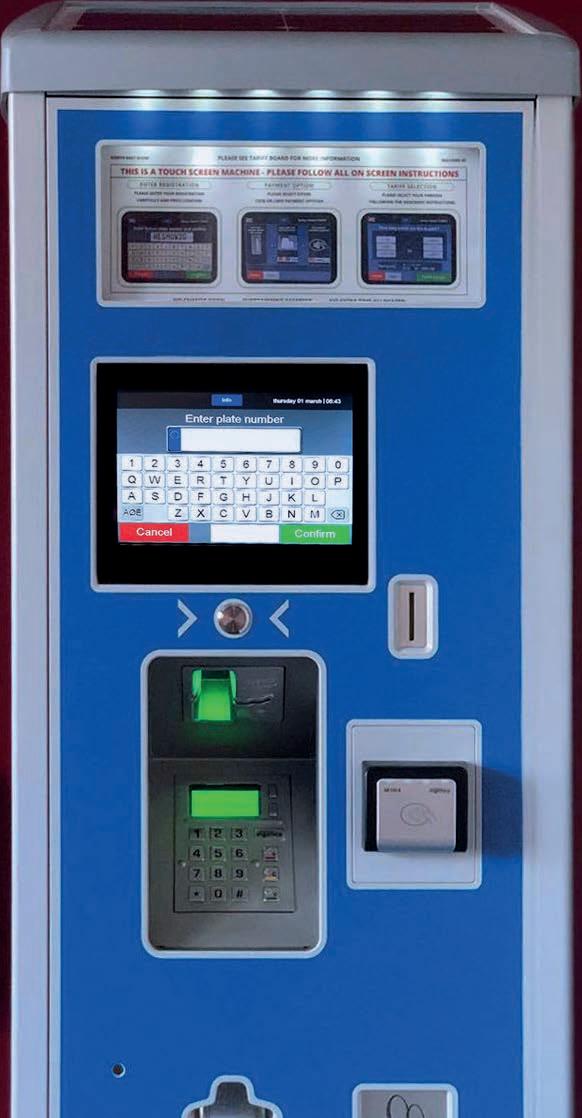
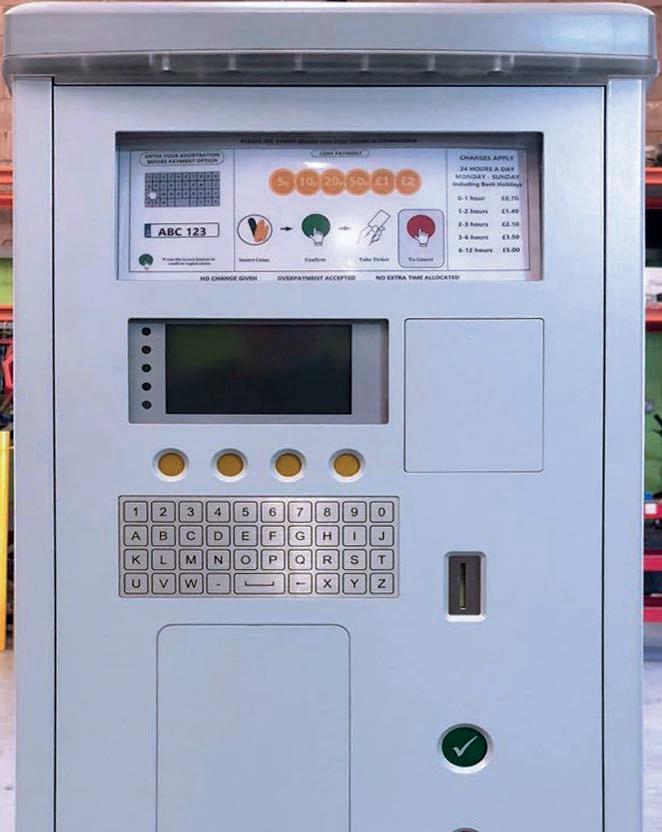












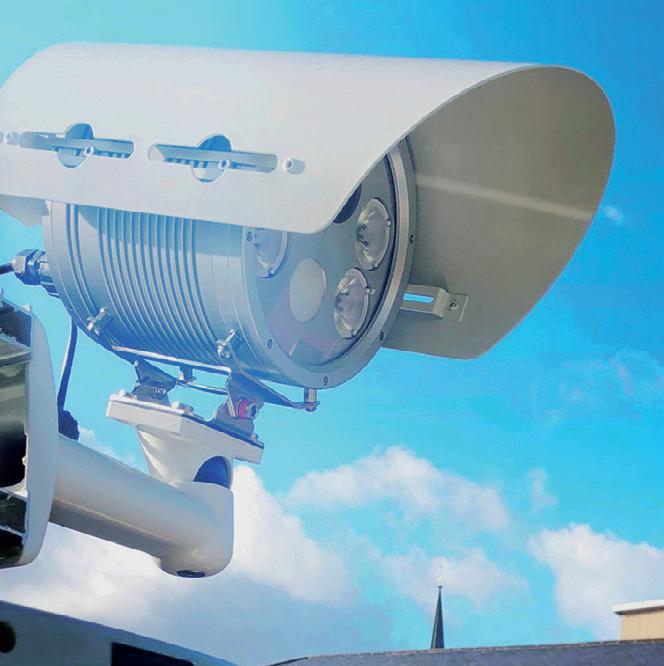






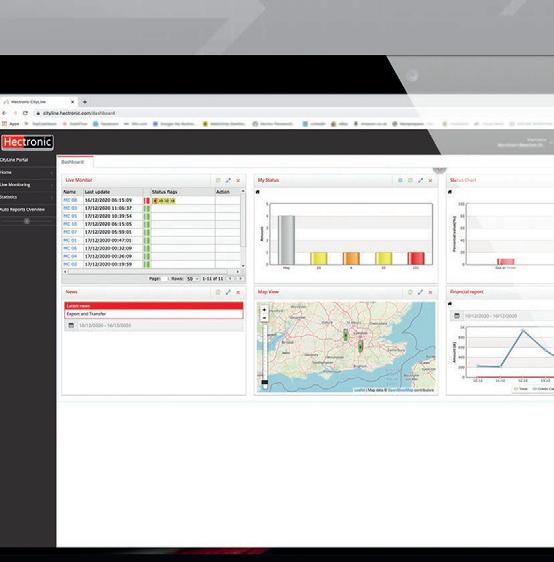





YourParkingSpace is a parking solutions provider committed to transforming isolated parking assets into connected mobility hubs, whilst also operating one of the UK’s leading on-demand consumer parking marketplaces. The company was co-founded by Harrison Woods and Charles Cridland in 2013. The pair have led its growth, with Woods working as chief executive and Cridland as chief information officer. Today, the business processes thousands of advance and on-demand parking reservations daily across the UK, generating £48.5m for its clients to-date. Its 85,000 space providers range from individual driveway owners through to household names such as Premier Inn, Tesco and Morrisons.
YourParkingSpace has been placed 86th in the Tech Track 100, the UK’s fastest growing technology companies, and 612th in the FT1000 annual list of Europe’s fastest-growing companies.
The company is also continuing to innovate, developing new services that reflect the evolution of mobility, such as partnership with fellow peer-to-peer providers in the car-sharing space and connections with electric vehicle (EV) chargepoint operators. It is also continually refreshing its relationship with the owners, operators and users of car parks.
Ahead of a major product announcement at Parkex 2022, we sat down with Brannan Coady, chief operating officer, who set out YourParkingSpace’s latest developments for Parking Review.

1. YourParkingSpace has continually evolved over the years, from a peer-to-peer marketplace to an end-to-end parking solutions provider and now the launch of YourParkingSpace ‘Solutions’. How would you describe the journey?
Brann an Coady : It’s a been a natural evolution over the years, each new service is an extension of the previous one. Starting off as a peer-to-peer sharing platform there’s a natural evolution into a fullscale parking aggregator. YourParkingSpace Solutions is a further extension of this, providing not just the booking platform but all the required technology to run car parks.
The technology we’ve deployed in car parks to-date has proven the value of the YourParkingSpace Solutions product suite, with this product suite now available to the industry.
2. What inspired the move to provide the full end-to-end parking solution for landlords and what is the business approach?
Brann an Coady : Running the marketplace allowed us to see firsthand the challenges and issues within the industry. It’s an industry with fragmented solutions operating within the same car park, many of which have fundamental limitations, and these individual solutions often have conflicting goals built into their products.
Take a standard car park. You’ve got the payment terminals which can often only be updated with notice and at a high cost, there’s no customer journey or interaction between these payment terminals and the cashless app. Any additional payment methods such as online pre-
book or AutoPay simply add additional fragmentation, and you then have a separate enforcement arm on top of this. It’s very disjointed.
We saw an opportunity to create an end-to-end parking solution which could address these issues.
3. Over the past 18 months how many sites have you deployed your full end-to-end parking solution in?
Brann an Coady : We have now deployed our end-to-end technology solution in 270 sites across the UK and Ireland, with an average of three new sites currently being deployed every business day.
4. YourParkingSpace has developed its own parking payment hardware. What was the reasoning behind developing this system?
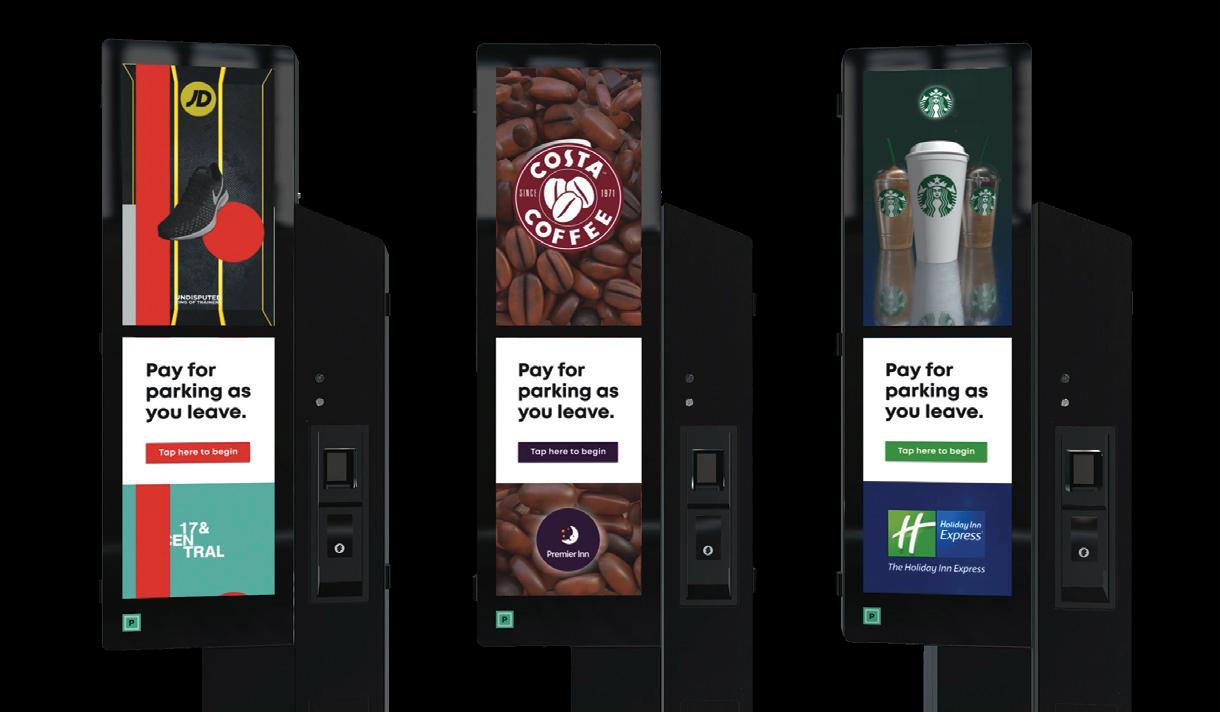
Brann an Coady : We felt there was a gap in the market for a parking terminal which firstly, had an intuitive user-interface, bringing the seamless booking process you see online to a parking terminal, and secondly, a parking terminal which was built to be connected to the cloud. The software has been developed to incorporate a real-time data connection, bringing elements such as instant tariff updates, dynamic pricing and access to real-time data.
Not having to accommodate any legacy hardware or technology when creating the parking terminal was certainly an advantage.
5. How important is the YourParkingSpace pre-book and subscription marketplace to your end-to-end parking technology solution?
Brann an Coady : It’s crucial. Our goal is to bring complete visibility with regards to how a car park is performing. However, it’s important that actions can be taken with that data to drive revenue. Elements such as tariff optimisation and dynamic pricing certainly have a part to play, but so does tapping into an alternative online audience via the YourParkingSpace marketplace.
Importantly though the YourParkingSpace Solutions product suite doesn’t just connect to the YourParkingSpace marketplace. If clients wish to connect to other marketplaces and have the green light from those marketplaces to connect then we can facilitate that.
6. What functionality does YourParkingSpace offer that other solutions in the market maybe cannot?
Brann an Coady : The product suite for YourParkingSpace Solutions has been designed with three elements in mind – creating the best possible driver experience, reducing internal administration, and maximising car park income.
We have seven different payment methods, ranging from the standard cashless app through to our payment terminals and AutoPay. Every payment method is designed to be as intuitive as possible to use as a driver and to take as little time as possible, replicating the online e-commerce approach of payments being as frictionless as possible.
Internal administration is minimised through ensuring all the components within the car park are connected to enable real-time data visibility and instant updates such as tariff changes.
We have an open API (application programming interface), available to be integrated with any provider whether it’s a tool such as Power BI for reporting and data insights or any external hardware or software. If a client or operator wants an integration our job is to deliver it for them.
Finally, we have a simple charging model. One single price that includes support, maintenance, unlimited API access, and no charges for ongoing software upgrades.
7. What lessons and challenges have you encountered since providing the end-to-end parking solution?
Brann an Coady : It’s been a big undertaking, building every solution component as a microservice which can operate independently and be fully customisable. It’s certainly brought its challenges internally in terms of the prioritisation of development work, ensuring for example that the marketplace continues to retain sufficient development focus.
When it comes to the solution itself I think we initially underestimated the complexities around the automatic number plate recognition (ANPR) solution. This was identified early on and over the
past 12 months we’ve developed our ANPR service from the groundup as the data is utilised in so many solutions, from the payment terminals through to the apps and analytics. Crucially, scalability has underpinned the entire ANPR service infrastructure.
Finally, on the ground we found that deploying the technology in a 30-space car park is not the same as in a 2,000 space car park. A 2,000 space car park magnifies any tiny imperfections with the service, if just 1% of customers have an issue of some kind this could be 20 people a day reaching out requiring assistance. These larger sites have helped shine a magnifying glass on these small imperfections and allowed us to improve the technology far beyond the ‘Version 1’ solutions.
Our experience in testing the solutions directly within car parks has without doubt given us insights which we feel gives us an edge over some of the incumbent parking solution providers.
8. Do you still use/integrate with other parking operators/technology providers and how does this work?
Brann an Coady : Absolutely. The components of our end-to-end parking solution can be taken in full or selected from in part, much like selecting items from a menu. For example, a landlord who intends to operate a car park themselves may decide to take every component of the solution. However, an operator is likely to want to plug their own enforcement solution and even payments app into the solution, for example only utilising our payment terminals, AutoPay and the marketplace. It’s a ‘mix and match’ solution, designed to operate as either a standalone end-to-end solution or integrated into existing services in the car park.
9. Is providing booking services for existing parking operators’ public spaces a growing market?
Brann an Coady : One of the effects of COVID has been to normalise the pre-booking of services and parking is no different. We’ve seen a very large uplift on a like-for-like basis when comparing pre-lockdown with post-lockdown and I’d expect this to continue.
10. YourParkingSpace ‘Solutions’ is officially launching at Parkex, what’s the vision for this part of the business?
Brann an Coady : Our goal is to become the leading parking solutions provider globally. If you have, or have been looking at, a solutions provider like SKIDATA, WPS Parking Solutions, HUB Parking or a comparable provider, you should now also be considering YourParkingSpace Solutions, the world’s most customisable digitallyled parking solution on the market.
To find out more visit Stand P300 at Parkex


After being run as a virtual experience during lockdown, the Parkex tradeshow returns as a live event for the first time since June 2019. The event, created by the British Parking Association, takes place at the NEC in Birmingham between 14-16 June.
Parkex 2022 will be taking place in parallel to the Traffex tradeshow, which focusses on highways and moving traffic management solutions.
For three days the NEC’s vast exhibition areas provide ample space in which around 200 suppliers will showcase their services. The Parkex areas of the show will feature stands displaying payment systems, electric vehicle charging, data management and a range of enforcement solutions.
A Parkex Innovation Trail showcasing stands hosting a selection of groundbreaking solutions will provide visitors with a pathway around the show. A panel drawn from across the BPA will judge the inventions being shown on the trail and the winner will be announced on the third day.
In parallel to the tradeshows there are conferences during both events. The Parkex Hub is an amphitheatre set up on the exhibition floor that will be home to a line-up of speakers will talk about themes such preparing for the Parking Code of Practice, demand management, fire safety in car parks and the path to net zero.
Alison Tooze, BPA head of policy and public affairs, put together the conference programme. “The focus on day one is to cover all the pertinent issues. It’s a combination of horizon-scanning and taking stock of what has changed,” she says.

“The first session looks at key challenges, changes in demand and behaviours, and the external influences such as the way people travel and emissions reductions that are going to drive us for next few years. Demand management is explored during a session on road user charging. It’s really interesting to see how road charging may influence and drive parking policy in response to it.”
Transport minister Baroness Vere will address delegates at about themes such as skills development and the future of transport.
From midday there will be discussions about schemes such as Park Active, which sees the parking sector supporting walking and cycling. There will also be an exploration of parking’s role in ridding communities of the blight of nuisance vehicles.
The afternoon will also address public safety and wellbeing issues, with a focus on fire risk in multi-storey car parks and ways of preventing suicide in car parks.
15 June: Public and private parking Day two at the Parkex Hub considers both private and public sector needs. The focus for the morning will be on the Parking Code of Practice and the regulatory changes affecting the private parking sector.
“There are two sessions during the morning,” explains Tooze. “One is focussed on the impact of the new code and some legal perspectives. The other will have a really diverse panel who’ll be getting together to talk about all aspects of what the Parking Code of Practice means to the sector.”
Meanwhile, BPA public sector members are invited to attend a Local Authority Summit which will discuss the regulatory changes they are facing, as well as giving them the chance to connect with key stakeholders and peers from across the UK.
“We want to give our local authority members the opportunity to come together to collaborate on areas of interest and to present, discuss and debate some of the most important aspects of the work that they do,” says Tooze.
The afternoon brings the private and public sectors back together with sessions including the importance of data in improving customer. “This session will look at the fundamentals of our role in the EV fuelling sphere. Should we be a primary EV charging source or not? This is a chance to try to take ownership of the issue and explore our place in it,” says Tooze.
There will then be a discussion about how to create a more diverse and inclusive parking sector, with the Women in Parking initiative rounding off the day with a panel debate.
Women in Parking will be holding a drinks reception, offering delegates a chance to mingle at the end of the day.

The final day sees the Parking Hub focus on training and skills development.
Tooze concludes: “Day three focusses on the most important asset we have, people. How do we attract people from all backgrounds, genders, and ages into parking, and how do we retain them and provide opportunities for them to progress?
“The hugely important issue of officer welfare will also be discussed. The title of this session is ‘It’s not just part of the job’ and that really highlights that we need to move on from abuse being accepted as part and parcel of a role.”
Parkex 2022 is free to attend
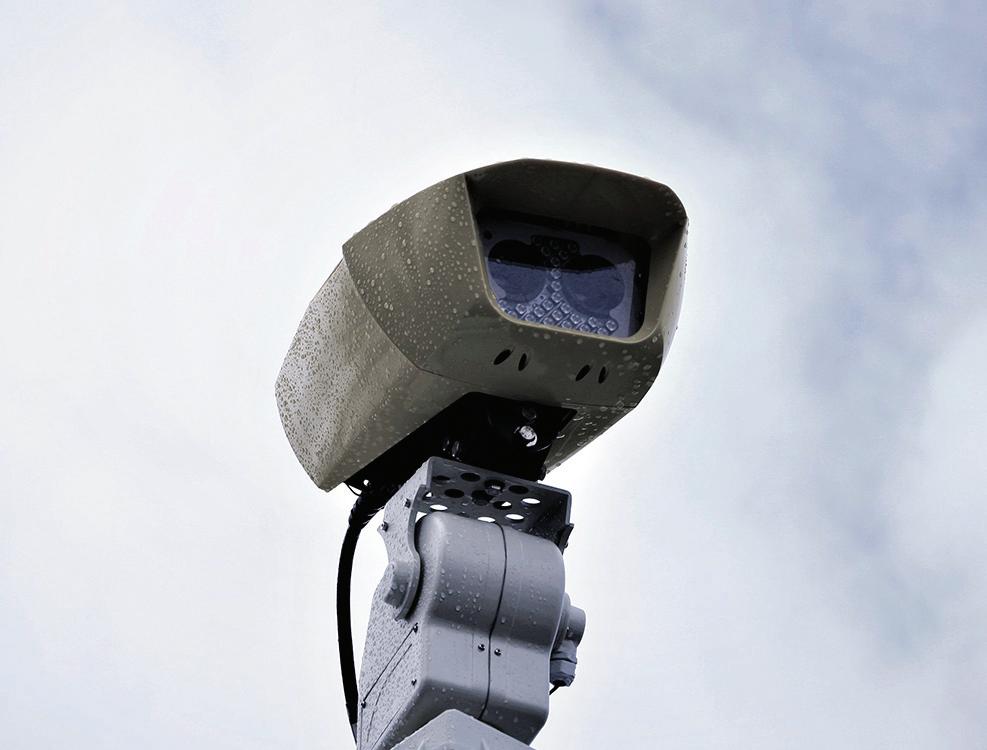
Yunex Traffic has been awarded a contract to design, supply and install a Clean Air Zone ANPR camera monitoring and enforcement solution across Sheffield City Centre.
The introduction of the Class C Clean Air Zone (CAZ) follows research undertaken by the city council which showed that air pollution contributes to around 500 deaths a year in Sheffield, with the largest cause of pollution being transport and diesel vehicles.
The Class C scheme will discourage drivers of the most polluting buses, coaches, taxis and goods vehicles from entering the zone and encourage them to upgrade to cleaner, low or no emission vehicles.
Yunex Traffic has worked with the council, the Department for Transport’s Joint Air Quality Unit (JAQU) and the other programme partners to develop a
system that will improve air quality across the city centre.
Wilke Reints, managing director of Yunex Traffic UK, said: “It is well known that road vehicles are the most polluting form of transport in the UK, with a significant amount of work to be done to reduce emissions and create a cleaner and more sustainable road network.
“Following the research undertaken by Sheffield City Council,
we are delighted to be working with the team to deliver a Clean Air Zone solution that meets the city’s specific needs. Once live in 2023, the Clean Air Zone will play a vital role in not only changing drivers’ behaviour, but ultimately reducing transport emissions and improving the health of those living and travelling in Sheffield.”
The company’s Sicore II ANPR cameras will be installed at 26
Camera enforcement specialist SEA has been awarded a contract by Bristol City Council to support the implementation of its Clean Air Zone, which is due to launch in September.

The agreement will see the installation of 49 ROADflow Fusion cameras, SEA’s traffic enforcement solution, at key locations in the city.
The ROADflow Fusion camera has been selected to detect vehicles that do not meet the zone’s emission standards by performing live identification via automatic number plate recognition (ANPR). The camera incorporates multiple detection devices to operate in different lighting levels and weather conditions.
A hosted back office then rapidly examines information such as a vehicle’s engine type and Euro rating to identify if it is compliant. The system can also integrate with multiple third-party systems, such as payment providers and penalty charge notice (PCN) processors, to enable enforcement for local authorities.
The system will be deployed to support Bristol City Council’s introduction of the Clean Air
Zone, which will help the city reduce harmful nitrogen dioxide pollution from vehicles.
A daily charge will apply to older and more polluting vehicles driving in the zone. This will be reinvested back into the local community, supporting individuals and businesses to switch to cleaner vehicles, ongoing work to make it easier to walk and cycle, and improvements to public transport.
David Bunting, head of traffic and highways maintenance at Bristol City Council said “The
Clean Air Zone will not only reduce air pollution but also help people change how they travel, delivering a cleaner, greener and healthier city for years to come. SEA’s ROADflow Fusion technology will allow us to effectively enforce the zone when it starts operating later this year.”
Alastair Cobb, head of transport at SEA, said: “Our traffic enforcement technology enables customers to change driver behaviour to improve the environment and road safety, and to reduce congestion. SEA
permanent locations across the city. The cameras will identify and register every vehicle that enters the zone, 24 hours a day, 365 days a year, with the information captured then being interfaced with the UK government’s national Clean Air Zone database for vehicle checking and payment.
Money raised through penalty charges will only be used to cover the costs of operating the zone itself, to support owners of affected vehicles, and for other schemes to improve air quality.
Sicore ANPR cameras have the ability to provide three-lane coverage with just a single camera.
The Sheffield contract follows implementation of schemes in London, Birmingham and Portsmouth. Wilke Reints said: “As the latest in a series of CAZ contracts to be awarded to Yunex Traffic, this is a further endorsement of our technology and broader capabilities, which are proven in projects worldwide to influence driver behaviour and improve air quality.”
is well placed to support organisations, such as Bristol City Council, through the implementation of Clean Air Zones thanks to our innovative traffic enforcement systems, including ROADflow Fusion.
“This intelligent technology offers the flexibility to support a wide range of clean air and low emission zone designs and enables schemes to be changed or repurposed over time as requirements evolve.
“Our dedicated transport team is based in Bristol, and we are delighted to be involved in such an important initiative in our home city.”
Many local authorities in England have already implemented Clean Air Zones, including Bath, Birmingham, Oxford, and Portsmouth.
Bradford joins Bristol in introducing its Clean Air Zone this year.
The ROADflow Fusion system has the ability to provide local authorities with Clean Air Zone and Low Emission Zone functionality alongside parking and moving traffic contravention enforcement such as bus lanes and gates, school ‘Keep Clear’, yellow box junctions and restricted routes if required.
Sicore II ANPR cameras to monitor junctions within Clean Air ZoneA Sicore II camera
Flowbird Smart City UK has rolled out a parking app at 14 Waitrose car parks across the UK. The introduction of the app gives shoppers the option to make a digital payment rather than using cash.


The Flowbird App is now available for use at Waitrose stores including Alderley Edge, Balham, Guildford, Monmouth and Rickmansworth.
App users book their parking session on arrival and receive a reminder when it is due to end, with the option to extend their stay whilst they shop. Shoppers are able to redeem their parking fee based on a small in-store spend threshold by showing the app, or a physical receipt if they paid with cash.


Flowbird reports that customer feedback has been positive, with users stating that they value the flexibility of using
cashless payment methods through their own devices, along with the ability to top up their parking on the go if needed.
Danny Hassett, Flowbird
Smart City UK’s managing director, said: “We are very proud to work with a respected retailer such as Waitrose to



use the app and get on with enjoying their time off.”
Andy Gruber, PayByPhone’s chief executive said: “As people finally venture out on their long-awaited holidays, adding almost 500 cities in Germany and Italy to the PayByPhone app is just one more way we’re simplifying their journeys.

improve the shopping experi ence. Thanks to Flowbird’s solutions, Waitrose’s customers can now pay for parking with apps, card and cash – so there’s an option for everyone.”
Waitrose customers can download the Flowbird App via a QR code located on the side of Flowbird’s parking terminals
Apple store.
The full list of Waitrose stores utilising the Flowbird app is as follows: Alderley Edge, Balham, Enfield, Guildford, Horsham, Leatherhead, Monmouth, Peterborough, Rickmansworth, Sevenoaks, Sidcup, Upminster, Wallingford and Wells.
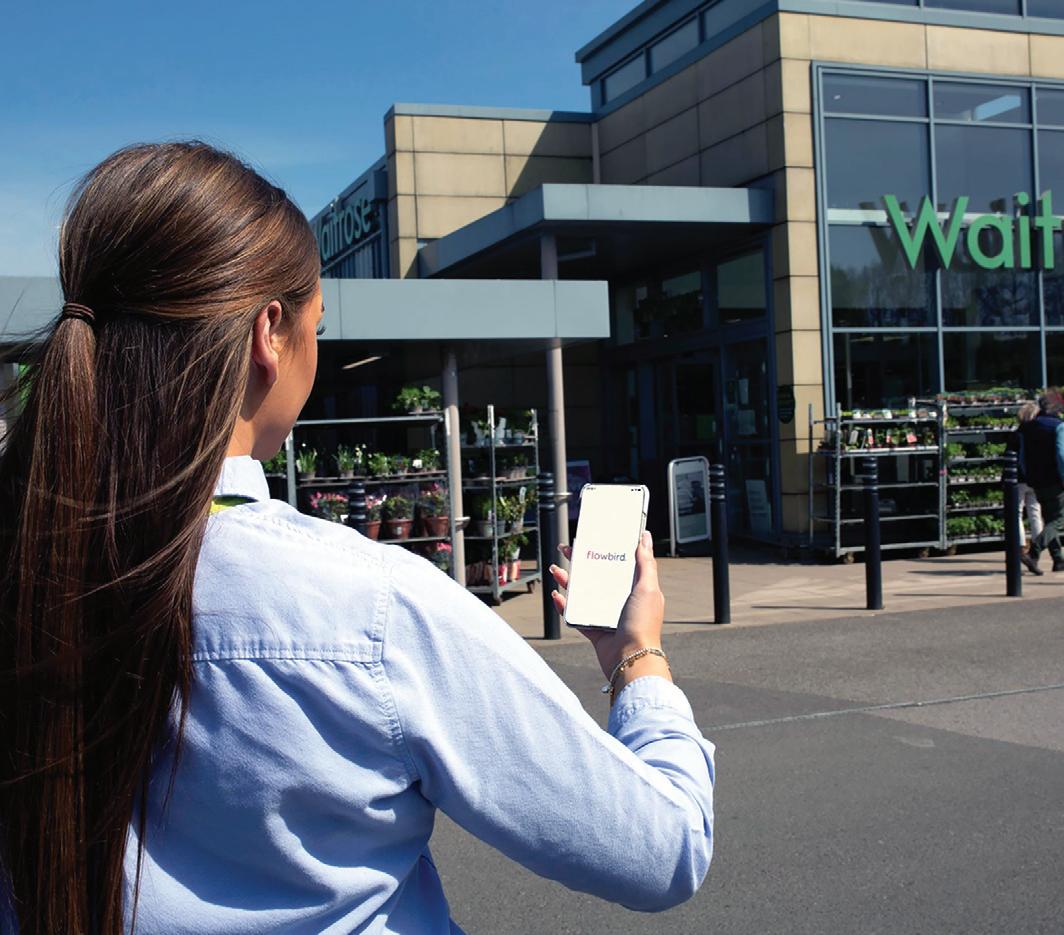
UK drivers heading overseas will be able to make mobile parking payments in 1,200 cities across 11 different countries using the PayByPhone parking app.
PayByPhone’s app allows drivers to pay for parking and to extend parking sessions remotely via its app in many cities. It also provides alerts that help drivers avoid parking fines. The PayByPhone app work across Europe and in North America.
The company has recently added 370 German locations and 100 in Italy. Anthony Cashel, PayByPhone’s UK managing director, said: “The expansion into a further 470 cities will help people as they take to the roads on holiday this summer, either in their own cars or in rental cars. They don’t need to worry about finding the right coins; they simply
“PayByPhone’s 50 million users can now use our app to pay for parking in big European tourist destinations like Berlin or Napoli, in addition to existing cities like Paris, Brussels and Amsterdam. If people decide to travel a bit further, they can also use PayByPhone to pay for parking of their rental car in cities across the US and Canada.
“Travel has finally rebounded with force across Europe after COVID-19, with people eager to get back to experiences they’ve missed out on over the past two years, In April 2020, we saw 86% of parking activities disappear in the UK and up to a 99% drop in European countries. Now, two years later, our stats show that parking activity is actually exceeding pre-COVID levels. Car travel has become even more important, as many people still prefer the safety of their own car.”
Morgan
A new multi-storey car park at Queen’s Hospital Burton has raised its barriers. The £6.4m structure has been developed by University Hospitals of Derby and Burton NHS.

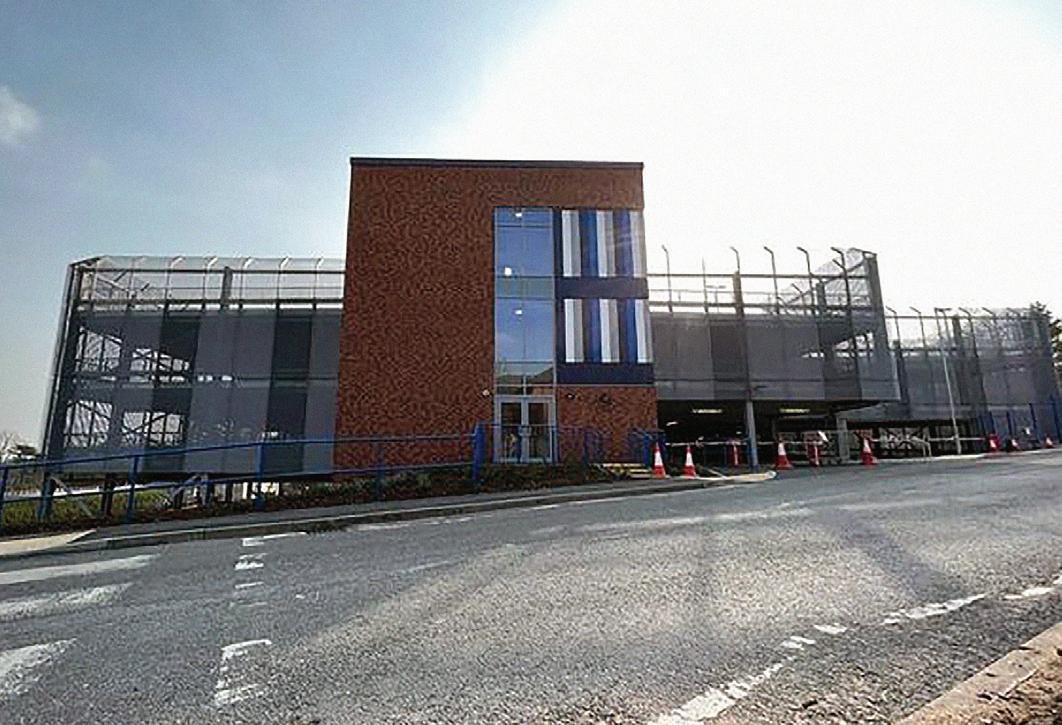
The multi-storey has been built by Morgan Sindall Construction. to a design by Gilling Dod Architects. Consultants on the scheme include Couch Consulting Engineers and Couch Perry Wilkes.
Paul Reed, head of capital projects at University Hospitals of Derby and Burton, said: “To build a multi-storey car park on a live hospital site was always going to be a challenge, but this was made considerably easier by everyone involved. Our construction partners, Morgan Sindall, worked incredibly hard
to ensure the project did not affect the day-to-day running of the hospital, but special praise should also be reserved for the capital projects, estates and facilities teams for all their hard work in taking the project from concept through to reality. The building will be a great addition to the site and provide a muchneeded facility at the Queen’s Hospital Burton.”
A cancer centre and multistorey car park are to be built on a shared plot of land close to Royal Surrey County Hospital in Guildford. The car park will be used by hospital staff and serve the GenesisCare Cancer Centre that will offer the latest innovations in cancer treatments.
The cancer centre and car park are being developed by Prime. After receiving planning permission from Guildford Borough Council earlier this year, Prime has finalised the finances for the scheme.
The six-storey car park will provide 600 parking spaces for staff. It will incorporate 30 electric car charging points, infrastructure for 30 more in the future and a security office with 100% coverage CCTV. This will free up additional parking
capacity for visitors and patients attending the main hospital who have struggled with availability of spaces for a number of years.
Both buildings are being built by VINCI Construction. Work started on site in May with construction on the car park anticipated to complete in spring of 2023 and the cancer centre in the autumn.
Bob Smaylen, development director for Prime said: “It’s always exciting to achieve the financial close of a project, reaching the moment when all partners commit and a concept becomes a reality.
“It’s an important milestone for Prime and for GenesisCare who, as leaders in cancer care, will be able to provide access to ground-breaking treatment to their patients in the region.”
The car park, which is currently for staff use only, has 499 spaces. It features 10 electric vehicle charging spaces and four motorcycle bays.
Cathy Winfield, executive chief nurse and director of patient experience, said: “The new car park will be a hugely valuable asset and help us to alleviate parking issues on and around the site and improve the experi-
ence of both our staff and patients who park on the site.”
The creation of the multistorey means Car Park 5, which has previously been used by staff and patients, has been converted solely for patient use. Parking outside of the Treatment Centre was designated for patient use only in 2021. A small car park located outside of Tom Davies House is set to be converted into a dedicated eight-space disabled car park, which has a wheelchair accessible route into the main hospital site. This will open to the public in Summer 2022.
Melissa Howe, facilities general manager at Queen’s Hospital Burton, added: “The project has been in the offing for so long, but this last year has flown by and now we have this amazing car park that will make such a difference. It has been a pleasure to work with such a wonderful professional team, so my thanks go to everyone involved.”
Greater Manchester’s park & ride facility at the Radcliffe Metrolink stop has reopened following the completion of construction works which have added 111 parking spaces. A parking deck added to the existing car park has expanded the number of spaces from 369 to 480.
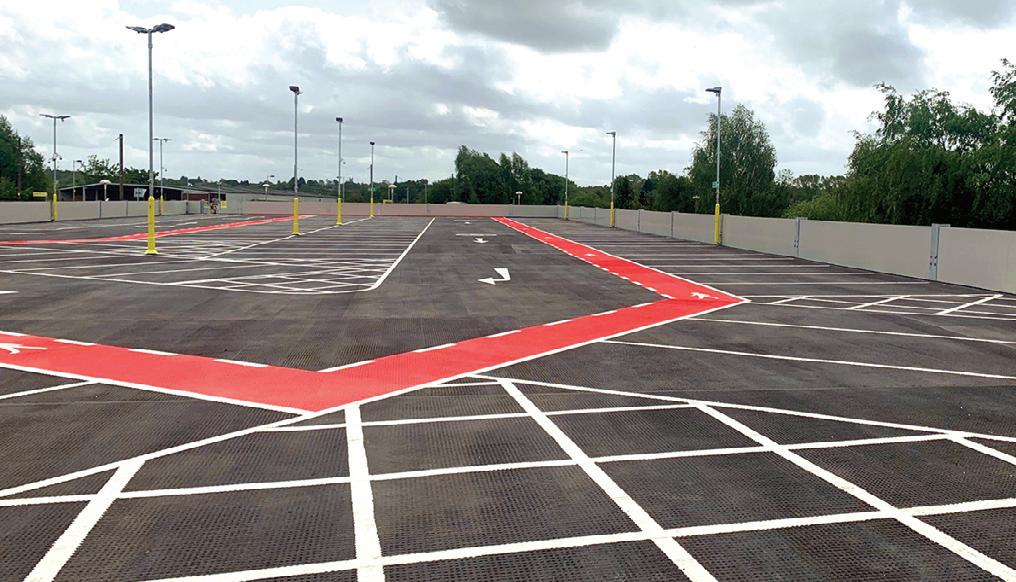
The extra parking will enable more people to access the Metrolink network and use public transport for part of their journey.
Andy Burnham, Mayor of Greater Manchester, said: “Park & ride schemes like this one are vital for the development of the Greater Manchester Bee Network vision by providing a truly integrated public transport system, making travel around our city-region easier, more accessible and affordable.
“This latest project means we have now created almost 600 new
park & ride spaces at three different tram stops across the city-region in the past 18 months, in addition to the thousands of park & ride spaces already available across the Metrolink network.
“By getting people out of their vehicles and onto public transport, even if it’s only for part of their journey, we can help reduce traffic congestion and decrease harmful emissions that are damaging the quality of our air.”
The opening of Radcliffe marks the completion of the broader Metrolink park & ride expansion programme, which has seen the construction of a deck providing 123 additional spaces at Whitefield and the 360-space site at Parkway on the Trafford Park line. There also plans to build a park & ride site at Walkden rail station later this year.
A distinctive design and commitment to sustainability have secured Victoria Leeds multistorey car park a Park Mark Plus accreditation.
Park Mark Plus incorporates the standards of Park Mark and Disabled Parking Accreditation, but also covers structural condition, environmental considerations, overall design, customer services, management and operations.
Daniel Tully, business support manager at Victoria Leeds said “We are incredibly proud of the car park and grateful that ACME the architects had the vision to build such an iconic landmark for Leeds city centre. We strive to deliver the highest standards, so all our guests have a safe and pleasant experience when visiting Victoria Leeds car park. We are excited that we will be investing further in our car park with new technology to enhance our frictionless customer journey.”
The city centre car park fea-

tures a striking diamond-lattice façade which comes to life when the sun shines.
Environmental sustainability is a key element of the Park Mark Plus award; the assessment included the availability of electric charging bays (of which the car park has 16) and energy saving equipment. The Victoria Leeds car park currently generates circa 20% of its own electricity. The facility also has secure cycle parking,
motorcycle parking and a bug hotel.
Ryan Davey, British Parking Association area manager, said: “Victoria Leeds is a very impressive multi-storey car park, which goes above and beyond to create an excellent customer experience. The staff are welcoming and put their all into ensuring the car parks high standards are continuously met.
“Customer expectations for well-managed, high quality car

parks are exerting demand on the sector to deliver an enhanced customer services whilst caring for the environment. Technology is also playing a growing role in delivering a seamless and efficient customer experience.”
The British Parking Association manages the Safer Parking Scheme for Police Crime Prevention Initiatives, with support from the Home Office and Scottish Government.
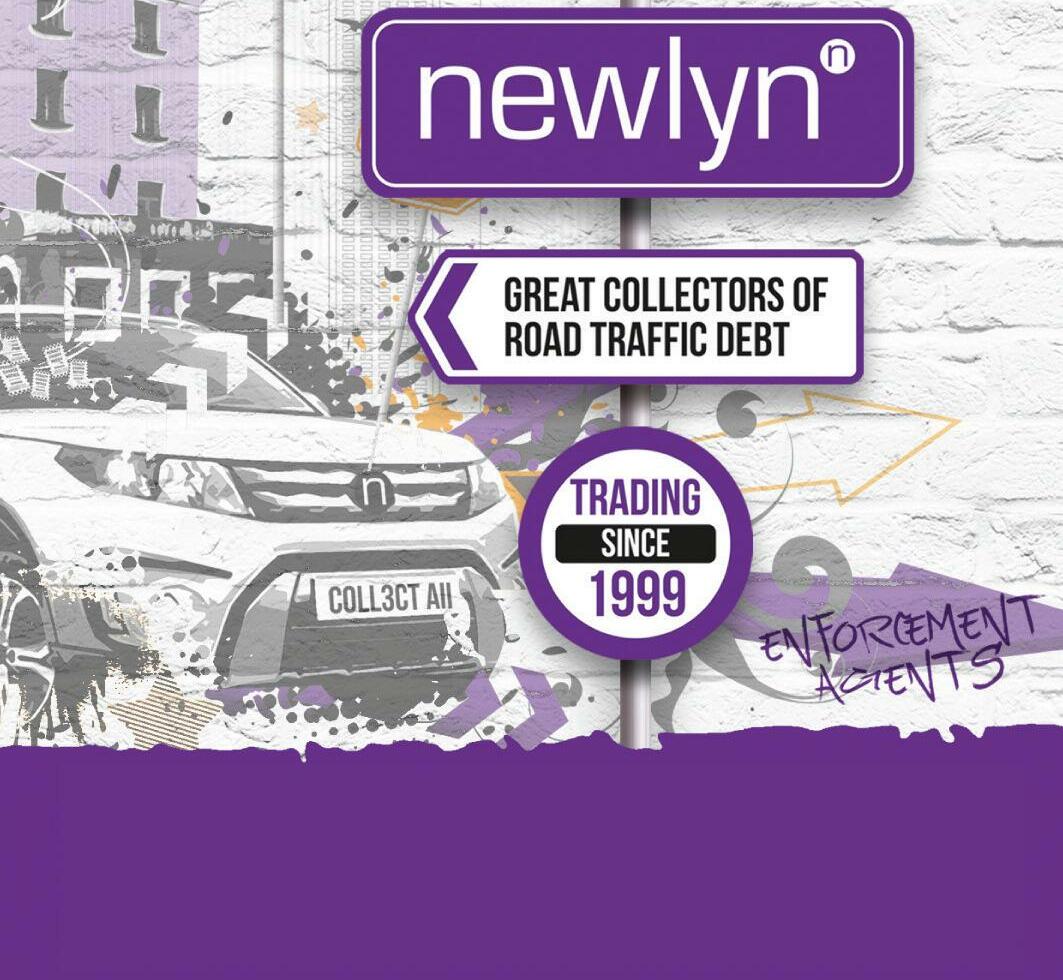




























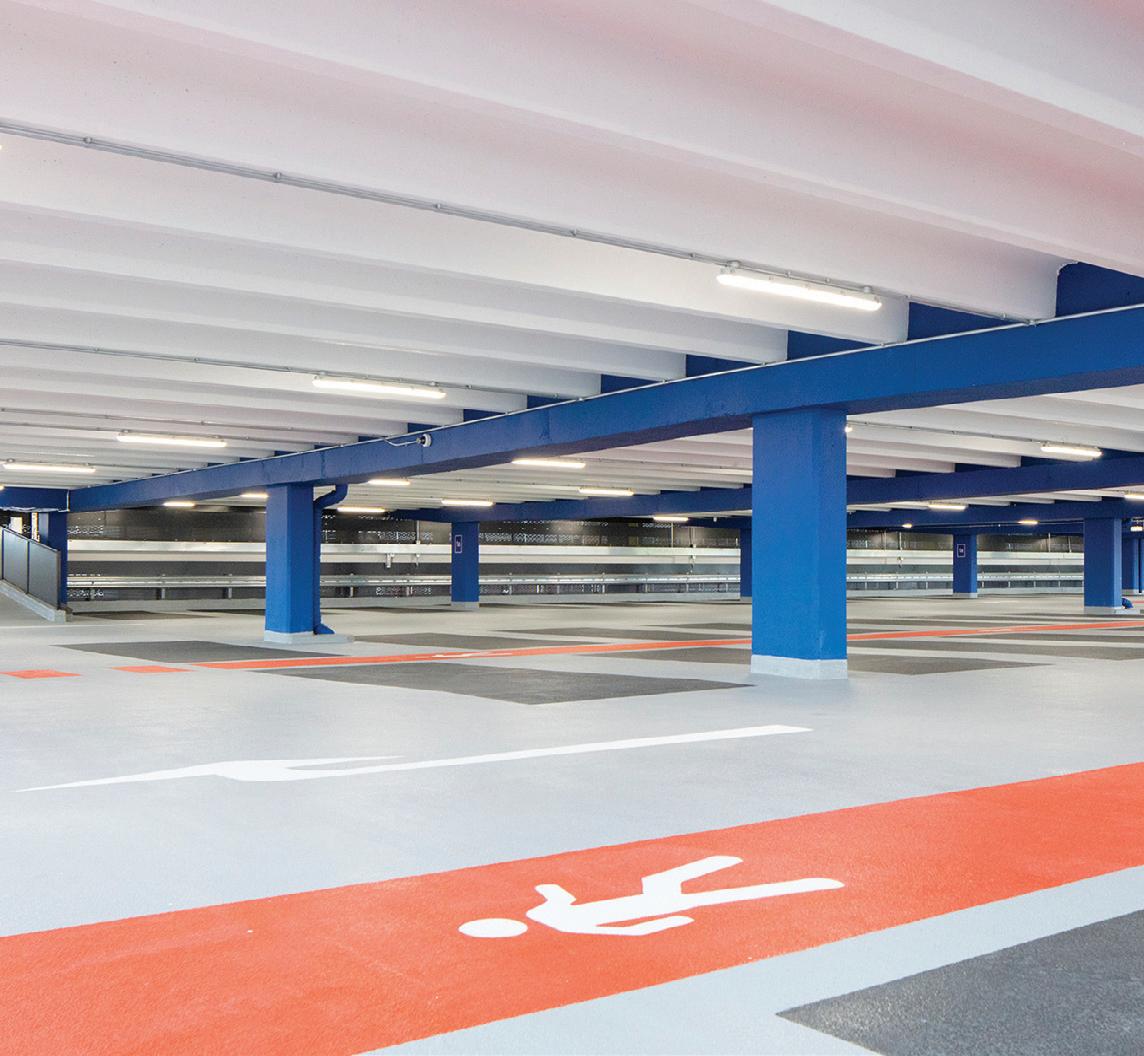







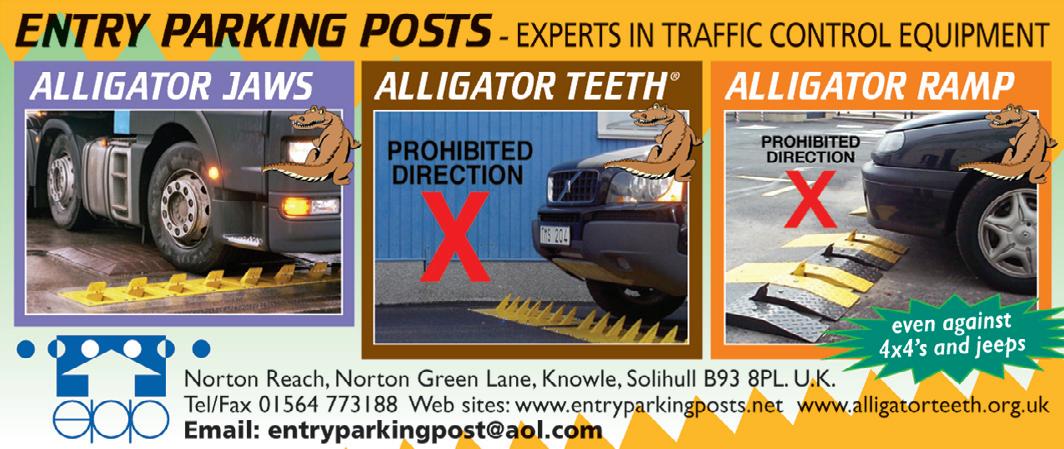
The next time you visit Folkestone seek out a building with a metal façade wrapped around a set of concrete decks. From the outside it could be a car park, but the proportions are wrong. When you check the interior the fact the decks are undulating makes it clear that this is not multi-storey for cars. It is, in fact, a skatepark.
F51 was not supposed to be the world’s first multi-storey skatepark. Commissioned by philanthropist Sir Roger De Haan, the original idea was that it should be a multistorey car park, but the plans morphed into a hybrid of the two, before settling on that which it seems everyone in the Kent town wanted: a skatepark set on multiple floors.
“We were originally asked to design a multi-storey car park,” says Guy Hollaway, architect of F51 – named after its location. “But when a nearby skatepark had to be relocated we were asked to incorporate it into the design. The client increasingly thought the cars looked boring, so we got
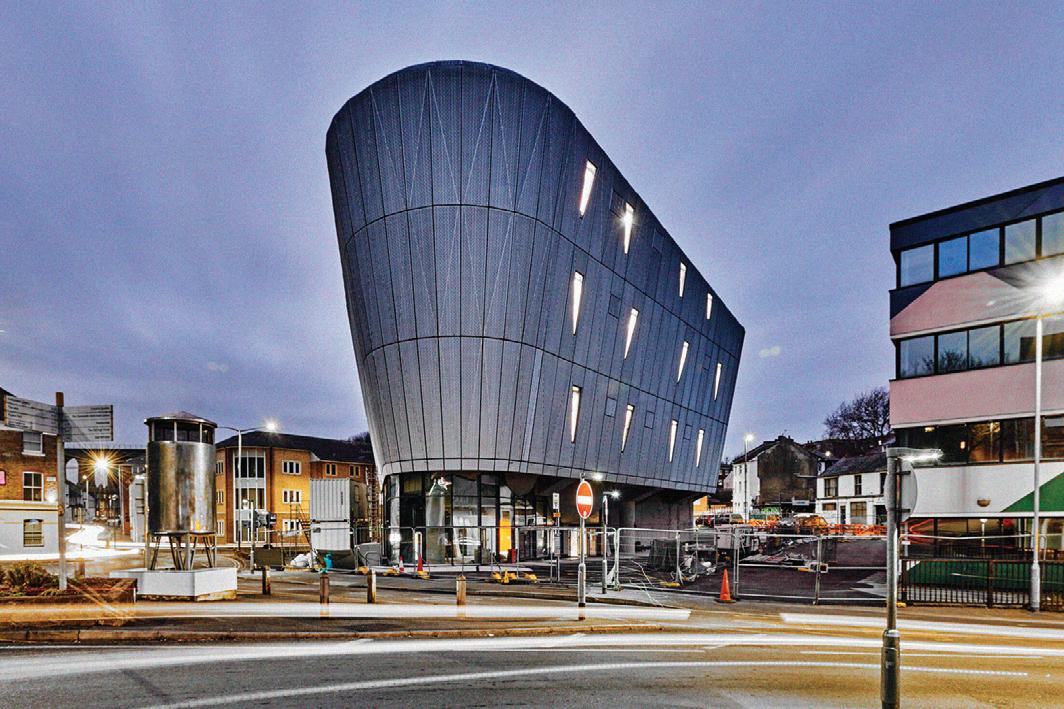
rid of them and made the world’s first multistorey skatepark instead.

“Skateparks are so often in dingy out-oftown locations. We wanted this to be a beacon right in the centre, saying to young people: ‘You’re the most important customer in town – because you are the future’.”
The skatepark features different levels devised by Maverick that cater for all ages and abilities, offering shallow ramps for beginners to deep concrete bowls for expert skaters and BMXers.

Work on F51 began in 2015 and was fea-
tured in Parking Review in 2016. However, it was delayed by work to solve various technical challenges and then COVID. Now that it is open, Iain Borden, architectural historian and author of Skateboarding and the City, regards F51 as a gamechanger. He told The Guardian: “It is as startling and shocking as the 1955 Citroën DS was for automobile design, and as cohesive and timely as the 2007 iPhone was for smartphones.”
De Haan made his fortune creating and then selling the holiday company Saga, which was based in Folkestone. The F51 skatepark is just one of many investments that his charitable trust has made in the town. It has funded an academy school, sports centre, galleries and studios, as well as giving the harbour with a new promenade. Located in one of the town’s most deprived wards, F51 offers a membership for just a pound a month, and serves as a one-stop shop for a set of social services.
Hollaway said: “F51’s mission is to give the young of Folkestone a place they can call their own, and where permission to take risks, to wonder, to have enormous fun, and to actively achieve results in that most natural states of being: a hugely happy childhood.”
Hedgehog highlights Mason’s DVLA concerns
Finding out that your name has appeared in Private Eye can be a cause for panic. But there are times when the satirical magazine is positive about those it writes about, especially when they are seeking to improve the way in which government bureaucracy (does not) work.
So it was that CDER Group’s John Mason felt some initial dread when he heard that he was appearing in the magazine’s ‘Road Rage’ column.
CDER’s director of road traffic and road user charging services expression turned to a smile when he learned that he was being quoted as voice of
reason when it comes to the thorny issue of DVLA data.
Private Eye’s columnist Hedgehog was exploring the problems presented by cloned vehicle number plates, which have become a “popular way
for ne’er-do-wells” to evade speeding and parking tickets or paying for toll road fees and congestion zone charges. Cloning sees penalties issued to the drivers of legitimate cars and makes tracing the scofflaws incredibly difficult.
Hedgehog noted: “The government hasn’t updated the DVLA’s remit to match criminals’ response to the growing automation of road charging and law enforcement. The RAC warned 20 years ago that vehicle cloning was growing, and now as many as a tenth of all vehicles on the road may be carrying cloned plates.”
Hedgehog drew on a cover feature for Parking Review, which reported on John Mason’s keynote address at the Persistent Evaders and Nuisance Vehicles Summit in March.
Mason warned that requests from legitimate authorities and agencies seeking to enforce parking and traffic penalties were hitting a brick wall because DVLA responds that it has “no keeper details”. Mason, whom Hedgehog calls a “veteran enforcer”, estimates that 10-20% of requests are met with this excuse.

Hedgehog wrote: “Mason reckons it’s far too easy for anyone to change information about a vehicle’s ownership with just a phone call or letter to the credulous DVLA.”
We are pleased to have helped raise both the profile of cloning problem and cemented John’s status as an enforcement guru. He told us: “It’s an accolade indeed, but when I was told I was mentioned I was a little nervous!”



